

CAMPUS CRISIS

Teachers vs Matatag
by JEZELLE BOMBIO



Studes demand tighter security, alarm safety concerns
by CHRISTIAN ANGELO PASTRANO
Expressing their disappointment, students demand tighter security after MONHS Coordinating Principal Julieto M. Indonto announced at a PTA meeting the implementation of new safety measures: students are now required to wear their school IDs, and a school guard has been stationed at the Annex area to prevent further incidents.
On behalf of the students, Supreme Secondary Learner Government (SSLG) President Aldryn Kwek emphasized the need for stricter measures, where he suggested implementing a “Wear Your Uniform” policy to easily identify outsiders.
“The school’s cyberspace is already vast. If there are outsiders, they have high chance to easily escape as it’s difficult to identify them due to wearing civillian,” Kwek said, stressing that students should feel safe attending school. Indonto, however, explained that forcing

students to wear uniforms isn’t feasible due to the importance of student autonomy, especially for those whose families struggle with financial difficulties.
ALARMING CRIMES
On September 11, 2024, an 18-year-old male intruder was arrested after being spotted entering the Annex building, searching for a specific student due to a misunderstanding, this situation escalated when the intruder was found holding a knife, alarming students.
Meanwhile, the intruder was released from police custody after a briefing and ever since his arrest, security guards have reported no further sightings of him or his companions on the MONHS grounds.
In a separate incident, while MAPEH teachers were away for the Provincial Meet,


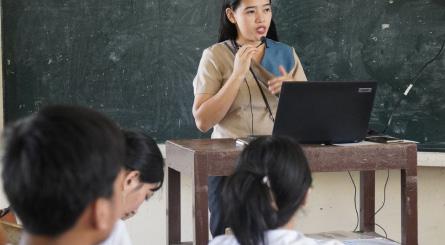
Teachers from MONHS have raised concerns about the insufficient time alotted for teaching, with some subjects facing time shortages, extending class times to one hour.
The implementation of the MATATAG Curriculum for school year 2024-2025 requires both students and teachers to adjust with the 45-minute class period across all Junior High School levels, making it difficult for them to cope with lessons.
Additionally, teachers faced workload struggles from the 45 minutes per subject schedule, stating that the average six classes they’d teach per day usually increase to eight due to the extra 15 minutes.
MONHS teacher, Aihrolyn Claire D. Gutierrez, expressed catching up with the time schedule of the new curriculum, “It’s not enough, especially to those teachers travelling distant classrooms. It takes about 5-10 minutes to get to the Main Campus from the Annex building, teaching time would further be shortened and won’t be able to accommodate the full 45 minutes.”
security measures, in
a bag containing a voice amplifier and other valuables was stolen from the Sports Coach’s office.
Students near the creek found some of the stolen items, such as a T-shirt, notebooks, and keys, however, the bag and other items remained missing.
After further investigation, the suspect and the remaining missing items were still not yet found, despite that, teachers remained grateful that some of their belonging were retrieved, “We’re thankful to the students from the Annex building who really found our things, at least, there are still some remaining,” they expressed.
In addition, wires and appliances were stolen from the supply office, and senior high school teachers reported missing valuables, including earbuds and money.

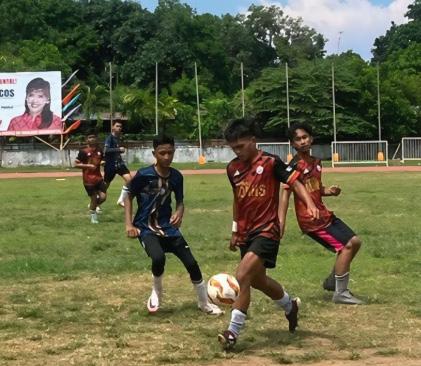
Monhs students criticize AI detectors’ bias
by ALFEIYA OMANDAM
The new curriculum has also tightened the schedules of the students and their time answering written works, resulting in them suffering from piled-up activities and increased stress, leading to a sense of pressure.
“Makabitin gyud kaayo ang 45 minutes time nga gihatag. Sometimes, we can’t finish discussions in our class, tapos during quizzes, we don’t have enough time to answer which affects our daily discussions and lessons,” Lhord Kian Pialago, a grade 10 student, said.
Even after this, MONHS continues to adjust with the MATATAG curriculum through further seminars for Grade 7 teachers to address struggles and challenges before its full implementation to other grade levels in the next school year.
by the numbers
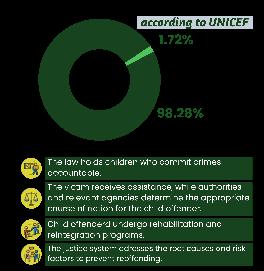
Learners raised concerns after discovering while checking their essays that AI detectors were misclassifying their work AI-generated, following findings from a recent Stanford University study.
The students learned from the study that non-native English writing, such as TOEFL essays from a Chinese forum, was flagged nearly 98% of the time, while essays from U.S. eighth-graders remained largely accurate. “Ga-use ko’g AI detector sa essay nako and surprisingly, it says AIgenerated ang essay nako. Alarming kaayo kay basin mahitabo sa uban tapos tarong ka nagtrabaho,” said Koleen Dela Rosa, a grade 12 student at MONHS. Dela Rosa, along with other students, is worried that the system’s biases might unfairly target their efforts to improve their English writing. The study reveals that AI detectors rely on a measure called “perplexity,” which gauges the complexity of word choices. Texts with simpler, more common words are flagged more often, putting non-native speakers, like those at MONHS, at a disadvantage. With unreliable results, students fear the technology could lead to wrongful accusations of cheating.
Students from Misamis Occidental National High School (MONHS) are questioning the effectiveness of the recent
fear of crimes recurring, believing that the actions taken by the school administration have been inadequate.
EVOLVED LEARNING. Mrs. Aihrolyn Claire Gutierrez teaches students in accordance to the new MATATAG Curriculum.
Photo by JESSIE BESIOHAN
MONHS declines in teen Pregnancy ranking
by CHRISTIAN ANGELO PASTRANO
MONHS Teen Center recorded a significant decrease in teenage pregnancy cases among students, from nine cases recorded last school year to four as of January 2025.

The school once ranked third in Region 10 for the highest teenage pregnancy cases in 2017, witnessed a significant improvement, now ranking 13th since 2023.
Guidance Counselor Fe Psychie Nival, credited the decline in cases to these ongoing efforts.
“We believe the responsibility lies in both men and women. Our campaigns focus on encouraging students to prioritize their education and delay early relationships,” Nival shared.
Additionally, the center’s counseling programs and awareness campaigns extend beyond the school, to the entire Oroquieta community, offering parental talks and family-oriented activities
“There is a need for
parents to be informed as well,” Nival emphasized.
She highlighted that parental involvement is crucial in addressing teenage pregnancy.
The school also conducted an adolescent and healthy youth awareness campaign targeting grades 4 to 7 students, ensuring early education on the consequences of teenage pregnancy.
MONHS relies on regular surveys and feedback from students to evaluate its programs.
According to Alexiah Zuerih Mancao, president of the Peer Facilitators school organization, these surveys are the instrument for understanding the school’s needs about what activities are effective and necessary to address teenage pregnancy.
Looking ahead, the school planned to expand its partnerships with local healthcare providers and community organizations to offer comprehensive support, aiming to improve access to reproductive health services and enhance its counseling programs.
Over 100 computers damaged, Monhs relocates computer lab
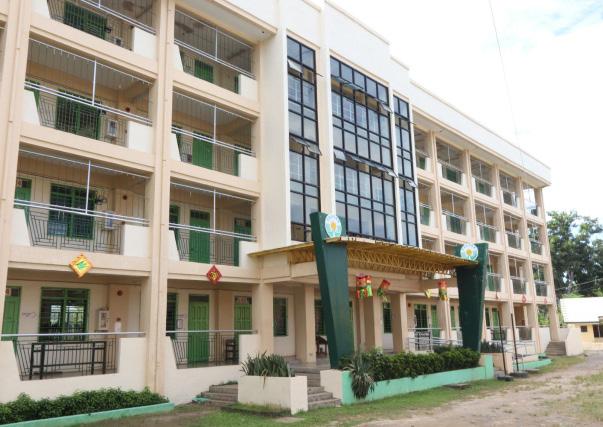
studes, teachers alarmed over power cuts, School admin curbs issue with Moelci
The school administration of MONHS negotiated with Misamis Occidental Electric Cooperative Inc. (MOELCI) to resolve the sudden power outage in the Senior High School (SHS) building. Three buildings in SHS lost electricity for almost
one day, resulting in class activities and research presentations being disrupted and moved to another building.
“While we had an important presentation in class, nag-brownout in the middle of it so many of my classmates ang wala naka utilize sa TV, but they need their laptops to present to the class, so medyo galisod jud sila ug present,” a senior high school student said.
happened even though we’re disappointed kay MONHS is such a big school, and it will leave you wondering why nawala ang current ug kalit,” a teacher in senior high school said.

abor workforce of MONHS unitedly transferred computer laboratories after a report of more than 100 damaged units caused by the massive flood in 2022.

With the help of Oroquieta City’s Philippine National Police (PNP), tables and equipment were moved from the Junior High School quadrangle to the Annex building by tying the supplies with ropes and pulling the materials up to the 4th floor. Due to lack of materials, the transport of the facilities, including tables and computers, took two days, considering the weight of the
equipment.
“Ang struggle, grabe! Kani gud sa ako lang room, duhang adlaw nilang hinakutay kay dili lalim. Naa’y nagtunton sa ubos [ug] pisi, naay tighikot, naa po’y nagbira diri sa taas. Ingon ana ka-struggle, ingon ana sila ka-luoy, maong nagsuhol pod mi nila,” Mrs. Ma. Robiesper L. Markiez, ESP Teacher, expressed her sympathy over what the school personnel went through.
Aside from the computer laboratories, garments and cookery materials were also transferred after some of their machines were
affected during the flood.
“Ang garments, kay na man gud pod na sila’y mga makina nga pangtahi. Kay naa man poy nabahaan nga mga makina, maong giapil pod siya diri ug saka,” Mrs. Markinez added.
Meanwhile, teachers were discouraged by the heat of the lab caused by the corrugated roof on the fourth floor, yet were still relieved that computer laboratories are now in a safe place. Despite the challenges, the school showed resilience and dedication to preserving students’ resources.
NEW YEAR, NO HOME
Mobod fire burns stude’s home
Five houses, including the home of MONHS student Liezel Gordillo were destroyed after a suspected electrical malfunction caused a fire in Purok 6, Barangay Mobod, Oroquieta City, on New Year’s Eve, where two people got injured.
The Bureau of Fire Protection (BFP) reported that the fire started around 6:40 a.m. and was out by 7:15 a.m. The BFP is still investigating the cause.
The fire left five families, including Gordillo’s, devastated.
“Maka-sad lang nganong nahitabo paman to na New Year kaayo. It’s just very devastating to see nga ang ubang pamilya kay nag celebrate sa New Year, while kami nawad-an na ug balay,” Gordillo said.
Locals said the fire went unnoticed, especially because because two families whose homes were destroyed were out of town for the holidays.
Gordillo explained that her family, along with others affected, faced financial struggles. To cope, they continued their business selling dried fish despite the tragedy.
The community, including the student body, has rallied to support the victims, providing food, clothing, and
other essentials, as well as additional financial assistance to rebuild.
Liezel added that they have repaired their home, and despite the adversity, families in Barangay Mobod welcomed 2025 with hope, grateful for each other’s safety.
Though the fire caused significant damage, it also brought the community closer, as neighbors worked together to rebuild what was lost. Many have expressed their gratitude
for the quick response from both local authorities and fellow residents, highlighting the strength and unity that emerged from such a devastating event.
Looking ahead, survivors have begun small-scale repairs and are optimistic that with continued support from both the local government and charitable organizations, they will be able to fully recover. The incident has also sparked a conversation about fire safety in the area, calling for greater preparedness.
Moreover, teachers expressed their disappointment over the incident, causing many rumors and questions among the students and teachers.
“Gi-understand namo ang situation while it
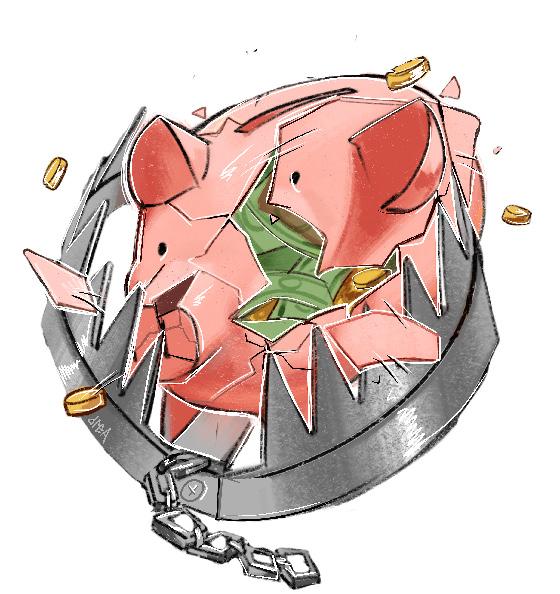
Meanwhile, the school administration cleared the rumors about the incident caused by “lack of budget,” saying it was false information, but rather a miscommunication of faulty calibration and technical issues. Students and teachers remained understanding of the situation and still resumed their classes using their phones while hoping that this issue wouldn’t happen again in the future, as it had disrupted the learning experience for all.
1.5M worth of supplies were damaged during 2022 flood.
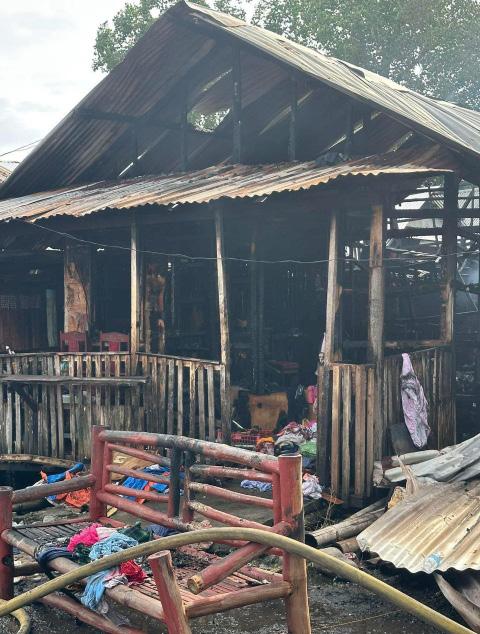
by ALFEIYA OMANDAM
by CHRISTIAN ANGELO PASTRANO
FLOODED FACILITIES.
Computers are covered in mud after flood, resulting to relocation of computer lab.
Photo by FRANCHEZCA PARAGUYA
NEW YEAR’S ASH. A Misonahisian’s house is left skeleton-like after fire in Mobod, Oroquieta City.
Photo by PEOPLE OF OROQUIETA
Photo by PAULA TAGUBAR
by JEZELLE BOMBIO
Source: MONHS Teen Center Data
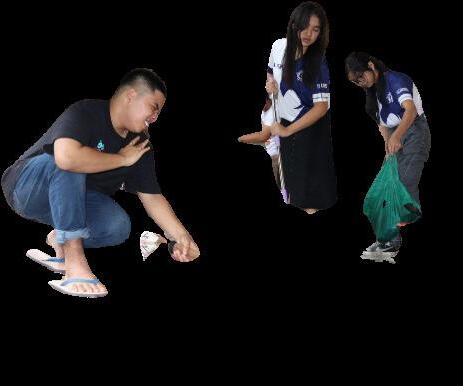
RAIN DELAYS, LESSONS RUSH
due to frequent flooding, Teachers, studes struggle with adjusted School Calender
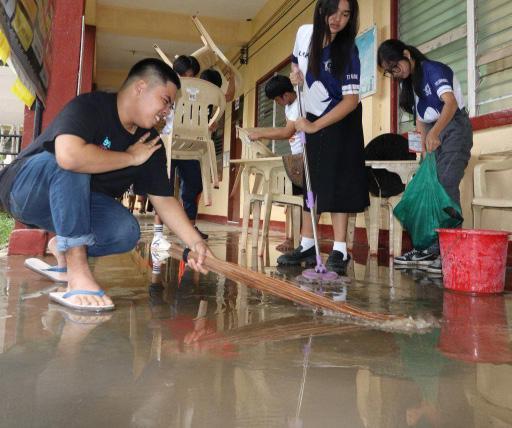
MONHS are having a hard time coping with the new school calendar, as classes are being interrupted due to continuous flooding caused by heavy rains.
Instead of having classes in their respective classrooms, teachers and students are busy cleaning their assigned areas, as their belongings were soaked by floodwaters, and their floors, covered in mud.
One of the students from ground floor, Princezz Tillo, expressed her frustration, “We swept and swept the floors of our room trying to remove the water, but the damage had already been done, and [with] just a quick heavy rain, waters are now
everywhere.”
With the shortening of this school year to reopen on June, the flooding resulted to teachers rushing their lessons, giving piled-up activities and modules to the students.
“Our teacher told me that we need to rush our topics, especially that we are catching up with the new school calendar, that’s why, we are given bring home modules or cutting out lessons,” Tillo added.
Furthermore, she emphasized that it’s time for
the administration to address the issue with proper irrigation and that flood prevention systems like water gates should be considered, highlighting the need for the school to invest in better flood plans.
Despite the upgrade of the drainage systems last school year, the situation has not changed and even moderate rainfall continues to disrupt classes, threatening the possibility of once again flooding the school grounds and affecting safety.
Monhs responds to suicide tragedy, expands mental health programs
DENGUEROUS
School clinic initiates disinfection of classrooms
MONHS advocates interventions from the Department of Health (DOH) for students and teachers
to religiously apply to prevent rising dengue cases, in response to the increase of dengue cases last school year.

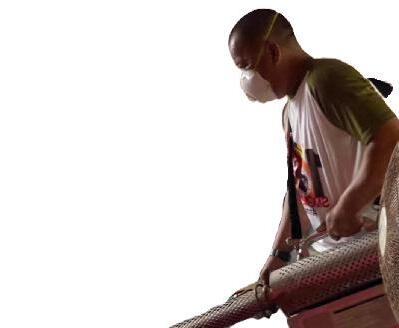

MONHS Teen Center promotes mental health awareness programs to help students with depression, aiming to provide education on recognizing symptoms, offering coping strategies, and encouraging early intervention after the first case of suicide incident.
According to Guidance Counselor
Fe Psychie Nival, the school is already conducting awareness campaigns prior to mental health every year including antisuicidal campaign, but became intensive after an incident.
She added that the campaign is not just
for MONHS but also aimed at involving the broader community, including parents, to help them better understand their children and seek guidance to offer better support.
“We are really also having campaigns involving parents because we know that these programs are not enough and would be better to have them guide their children also,” Nival explained.
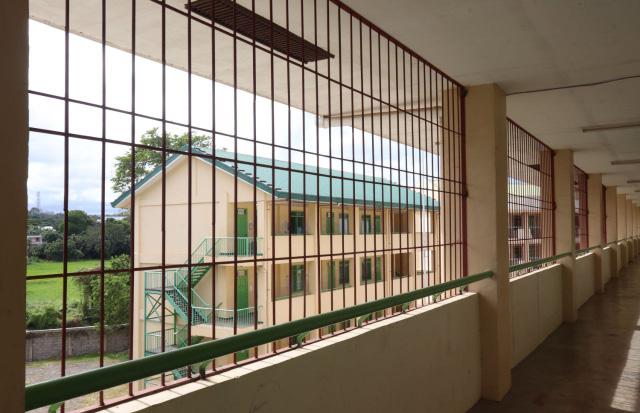
To validate the result, Teen Center uses Rapid Heads form, screening students for comprehensive interview, and conducted training race against suicide, with the help of the Department
of Education (DepEd).
Nival emphasized the effectiveness of the campaigns, saying that the activities implemented were successful but effectivity still depends on the person.
“When we say training, the capabilities and abilities, they can say nga 100% naa, pero in terms of effectivity, it depends on the person who is experiencing depression, anxiety, and stress,” said the guidance counselor.
After the tragic incident that involved the self-inflicted passing of a student within the school grounds, a special scheduled mass became a monthly occurrence as the School Administration, through the Campus Ministry, desired to establish prevention measures which addressed students’ welfare.
Moreover, since the last school year 2023-2024, the school had been more considerate with the students’ mental health, promoting Psychosocial First Aid Orientation to parents and students during Brigada Eskwela before the start of classes and classroom-based Psychosocial Activities during Catch-up Fridays.
DIScomfort rooms
ADMIN’S RESPONSE
In response to the ongoing security concerns, the school administration has intensified efforts to monitor the school grounds—a guard has been assigned to the Annex area, and additional security measures are being considered.
However, budget constraints have limited the number of guards available, leading to shorter shifts and reduced coverage resulting the school to reach out to local barangays for additional support.
Despite these efforts, students remain hopeful for better protection, urging a thorough investigation into the crimes and accountability for those involved—they fear that continued security risks may force students to transfer to other schools for their safety. The school’s response, however, begs the question if the measures would maintain their peace of mind.
nurse Mellen Joy Lood, the school recently observed a drop in dengue cases compared to the previous school year, with eight patients and no deaths as of November 2024 this year.
All dengue cases were treated, with the eight cases involving six Grade 10 students and one student from Grades 7 and 12, while the previous year included five students from Grades 9 and 10, one student each from Grades 7, 8, 11, and 12, and one teacher.
”The interventions advocated by DOH are 99.99% effective, but the challenge is the frequency and how religiously these measures are applied,” Lood said.
MONHS Red Cross Youth (RCY), guided by Jelfa Dulalas, the Dengue Program Coordinator, implemented an activity
School Admin to prioritize water system repair in dirty toilets
by VENICE MARTE
School Principal Julieto M. Indonto of MONHS has assured repair of the school’s water system, as students expressed frustrations on unsanitary comfort rooms, posing health risks due to lack of reliable water supply.
Indonto emphasized that the school is focusing on restoring the water system, including plumbing and fixing water tanks, after students reported frequent interruptions to water flow in the CRs. This issue has forced students to avoid using the bathrooms.
A Grade 10 student, Hannah Abella, shared her daily struggles caused by these problems, making her use other bathrooms with functioning water supply.
“Maka-apekto jud siya kay kana bitaw’ng naa’y mangihi, tapos dili sila makaihi, kay
wala’y tubig, kay kung mangihi man gud sila, naay musunod, so manimaho ang CR,” she explained.
Abella also noted that the lack of consistent water supply forces students to use the bathrooms even when there’s no running water, leading to unpleasant odors and poor maintenance.
Elyssa Bantula, a Grade 10 Dalton student, emphasized the importance of a reliable water supply and maintaining cleanliness in the comfort rooms to prevent health risks, “Importante jud siya ‘cause
comfort room gud siya. So if baho ang atong comfort rooms, then dili siya mag provide ug comfort and basin mainfection pata kay tungod hugaw ang CR, labaw na kay naay uban dili hinloan ang CR,” Bantula said. For now, students hope their concerns will be addressed quickly, highlighting the need for improvements to ensure the comfort rooms remain functional, sanitized, and free of the daily struggles they currently face.
where they pour Sumilarv in swampy areas around the school to kill mosquito larvae in stagnant waters.
In addition, the City Health conducted three fogging sessions in MONHS during the dengue outbreak in Oroquieta City.
City Health workers have also surveyed MONHS classrooms for larvae, where they found that buckets and water dispensers usually contain mosquito eggs; thus they encourage teachers to remind students to empty or close watery areas.
Lood also mentioned that the school clinic will serve as a station for students to apply mosquito repellent, observe proper hygiene, avoid dark areas, and maintain cleanliness around the school to help prevent dengue cases and potentially make MONHS a completely dengue-free school environment.

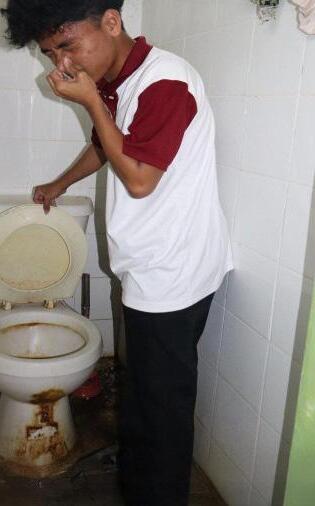
by CHRISTIAN ANGELO PASTRANO
by CHRISTIAN ANGELO PASTRANO
by JEZELLE BOMBIO
A MOSQUITO’S NIGHTMARE. MONHS staff observes fogging, emphasizing the critical role of safety measure in safeguarding communities against dengue.
Photo by FRANCHEZCA PARAGUYA
BARRIER TO DISASTER.
Photo
Photo by PAULA TAGUBAR STINKY
Photo by JESSIE BESIOHAN

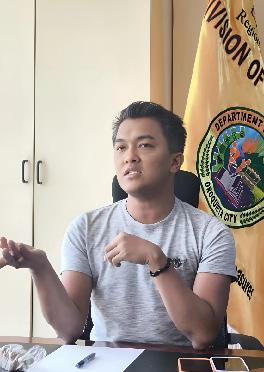
Oroq Division girds for RSPC through enhancement series
by CHRISTIAN ANGELO PASTRANO
Division Journalism Coordinator Jay Roferos promotes to upskill student-journalism skills by inviting caliber speakers from the National Schools Press Conference (NSPC), aiming to improve the ranking of Oroquieta City in terms of Journalism across the region.
From ranking last out of 14 divisions on 2022-2023, the city division conducted enhancement trainings, with the help of national trainers, monitoring teacher coaches and campus journalists from their training plans and activities.
As a result, the division has sent 8 journalists to the NSPC, including one from the individual categories and 7 from the group category.
Roferos emphasized the effectiveness of the said initiatives after team Oroquieta garnered various awards. He believes that that they improved way better, far from their previous performances.
“We dont only sustain our good practices last year, we even step up from our previous practices just to increase our wins in the RSPC and increase NSPC qualifiers,” Roferos stated.
In addition, the city division has already started to conduct enhancement trainings for the school paper and group categories, as well as a short course of English and Filipino grammar, in preparation for the upcoming RSPC on March of 2025.
“These activities are very important to hone our campus journalists more and even scaffold their learnings, as well as to upskill school paper advisers in the field of Journalism to make our journalists champions in life,” Roferos added.
Moreover, Roferos highlighted the leadership under Schools Division Superintendent Jean G. Veloso, in collaboration with the Local Government Unit (LGU), where they remain confident in any funding shortfalls to be addressed through creative and resourceful solutions. Last year, the LGU granted P100 fund for each participating district during the RSPC in Cagayan de Oro City.
Misamis Occidental NHS teachers urged students to avoid participating in harmful TikTok trends, in order to prevent more incidents caused by social media, after two students were left injured.
After bringing the two students to the the clinic, the school nurse convinced the teachers through their group chat, to warn students from performing the Tiktok trend.
“I reported the incident to the guidance office and warned the class not to repeat it to avoid further accidents. The school nurse immediately sent a message to our group chat to reprimand students from performing the Superman TikTok dance,” Flordeliza Docor, Pahilangco’s adviser, stated.
Grace Joy Pahilangco from Grade 10 Dancing Lady was hospitalized after attempting the trend, hitting her head on the wall, while Loren Faith Tizon from Grade 8 SPA Brocka was rushed to the school clinic for treatment.
According to Pahilangco, her classmates convinced her to go to the school clinic
to treat her head, but after frequent vomiting, Pahilangco was rushed to the hospital.
“My classmates asked me to join the TikTok trend, unexpectedly, I hit my head on the wall, but I got better after getting discharged from the hospital, except that I’m still experiencing headaches often,” Pahilangco expressed.
Moreover, Tizon mentioned that he and his classmates were curious about the trend, however, his classmates failed to catch him, leading to him hitting the ground head-first.
Pahilangco and Tizon have now both recovered from their injuries, but their experience serve as warning to their peers to consider their safety first when trying to follow with trends, preventing lifethreatening accidents.
TRENDING TROUBLE
Students suffer injury from Superman challenge
by JEZELLE BOMBIO


ECCENTRIC EXPRESSION
Cosplay pageant inspires studes’ creativity, confidence
by JEZELLE BOMBIO
MONHS held its second Cosplay Pageant since the pandemic, encouraging students to showcase their interest for the National Reading Month, on December 16, 2024 at the MONHS Covered Court, where 52 student participants seized the opportunity to express themselves through the art of cosplay.

GECARL SIEGA

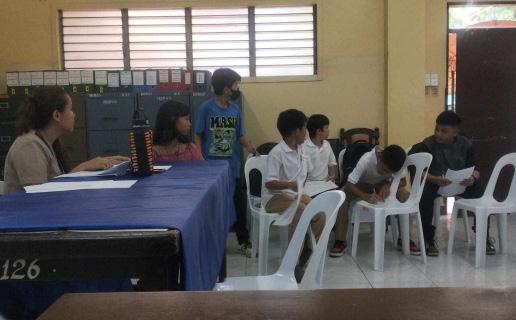
Miles Kian Tejano, a Grade 9 Carnation student, shined the event as he was crowned Mr. Cosplayer 2024, while
Gweyneth
Cianna Villanueva, a Grade 7 Archimedes student, grabbed the title of Ms. Cosplayer 2024; Chris Nathan Albinda and Julianne Carmelle Bueno also showed an incredible performance
Mafter bagging the Best in Production.
“Winning the event was like a dream come true. I didn’t expect it, especially as a first-timer. I’ve always admired cosplay events but never had the chance to attend one, so it was surreal to finally be part of it,” Villanueva expressed her reaction after the coronation.
Villanueva sees cosplaying as a form of creative expression and a passion that has captured her heart, claiming that it’s more than just dressing up — it has the power to bring people together, connecting fans through shared interests and creativity.
“I wanted to try new things and showcase
my confidence to inspire people who are scared to show their talent and skills on stage,” first-timer, Romella Irish Senit said, enjoying the experience despite not being a top 10 finalist.
Meanwhile, one of the finalists, Cryzzra Bulawit, shared that the cosplay pageant motivated her to make cosplaying a hobby where besides art and creativity, cosplaying for her is being able to express a side of what was once unknown.
Overall, this year’s cosplay pageant highlights the creativity and confidence of students, pushing them to come out of their comfort zone and express themselves uniquely.
ONHS mainstreamed students with learning disabilities (LD) into regular classrooms to foster a more inclusive learning environment, working to create a supportive community for all learners while offering growth opportunities for educators.
Mrs. Claudine B. Marchan, Master Teacher in Special Education (SPED), emphasized the inclusion of students with learning disabilities in mainstream classrooms, where this approach not only helps prevent discrimination but also enhances social skills by encouraging interactions between students with diverse disabilities.
Mainstreaming is suitable only for students whose needs can be met through general classroom strategies, such as those with reading comprehension difficulties, Dyscalculia, or slow processing speed.
Students with more complex needs, such as Down syndrome or intellectual disabilities, cannot be supported in the regular classrooms at MONHS—these students are placed in self-contained
classrooms, where a SPED expert provides specialized care.
To support integration, the school has introduced a ‘buddy system’ which designates classmates to assist their peers with learning disabilities. The system may be voluntary, will follow a rotation schedule, or allow students to pair with someone they they choose and feel comfortable with.
Mrs. Marchan noted that while the buddy’s role is to offer support, it is the teacher’s responsibility to design and implement activities tailored to the needs of students with disabilities. This approach reflects a progressive step toward providing equal learning opportunities for students of all abilities at MONHS where no learner is left behind.
MOLDING CHAMPS. Oroquieta City Division Journalism Coordinator talks with student journalists about the enhancement program.
Photo by FRANCHEZCA PARAGUYA
SUFFERMAN. the ‘superman’ Tiktok trend. Source TIKTOK
Abuton bags Mindanao Quiz silver despite short notice
by MARNEL KEISHA CABURAL
Zacque Landre Abuton, grade 12 STEM student of Misamis Occidental National High School (MONHS), garnered 1st Runner-up in the 5th Mindanao-wide Energy Quiz Bee Final Round with only a week of preparation.
Despite being disadvantaged, Abuton showed a brilliant display of knowledge and adaptability to push through and perform under time and mental pressure that led to his triumph.
“Wala ko ga expect kay akoang mga kontra is well-prepared, they prepared for like months before the competition,” he explained.
His achievement highlighted the importance of hard work and the reality most competitors experience, with him managing to succeed despite limited preparation time.
Unlike his opponents, Abuton also struggled to train properly. Juggling research competition and field demonstration forced him to pull allnighter reviews.
He added that it was his first time competing in the event, and was informed a day before the region-wide competition, he initially only joined for the sake of representing the school.
“I think it would be better if next time the management or the people assigned for that certain task should be more mindful and have better communication in general, because
this could potentially have an impact or salvage the situation,” despite his feat, he expressed his frustration about the last minute announcement of the contest.
MONHS applauded his win, and Abuton shared this moment as an inspiration for his co-students, emphasizing that with confidence, composure, and perseverance, you can overcome any challenge. He encouraged everyone to believe in their potential and push through obstacles., no matter how difficult they may seem.

FAILED SPARK
4 people injured after failed fireworks show: BFP to expand safety distance
Oroquieta City — Bureau of Fire Protection (BFP) advised organizers to maintain safety distance between the audience ensuring the safety of the crowd, after fireworks display accidentally fled toward the viewers, causing 4 people injured, including a child.
During the 2nd entry of the Fireworks Display Competition, Oroquieta Fire Station emphasized that strong winds toppled the containers of the fireworks that resulted to explode in the street.
“It was so scary. People are really running away from our area as the fireworks fled towards us while I was watching the display with my family,” expressed Lhord Kian Pialago, a grade 10 student from Misamis Occidental National High School (MONHS).
Meanwhile, people involved in the incident were assisted
immediately as the ambulance, along with the medics was present during the show.
Prior to the next fireworks performance, Oroquieta City Official Website posted on Facebook the postponement of the 3rd entry of the competition as Department of Interior and Local Government (DILG) and Oroquieta City Police investigate what happened during the incident.
However, Mayor Lemuel Meryrick Acosta announced on Facebook the continuation of the next entry after some
reconsiderations, “Nakita nila maskin katong video clips from our CCTVs, nakita nila ang sitwasyon and I was told earlier na all systems [were fine] and mag padayon ang atong fireworks display karong gabiehona.”
According to the City Disaster Risk Reduction and Management Office (CDRRMO), there are no serious injuries caused to the 4 people involved in the incident and assured the continuation of the next entry after reconsiderations, while still implementing additional security for prevention.
Robots flash during Org Fair
by VENICE MARTE
Robotics club drew a crowd with its impressive display of cutting-edge technology along with other organizations who exhibited their different-themed booth at the highly anticipated Organization Fair.
the school administration.
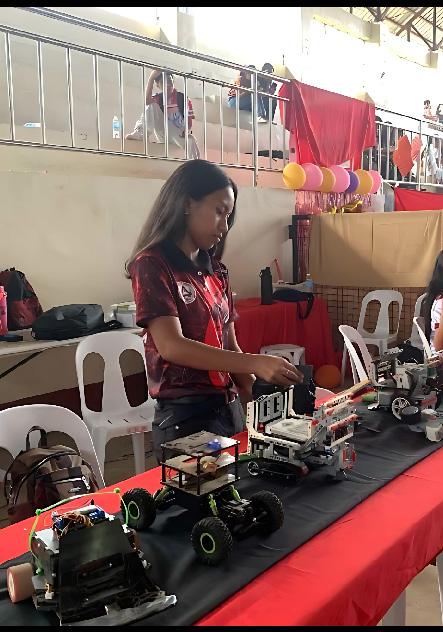
The club showcased their innovations that highlighted the new Robotics subject piloted in S.Y. 2023-2024 to STEM Curriculum.
“The Organization Fair serves as a platform to introduce studentled organizations to the rest of the student body, providing a sustainable way to build memberships and foster involvement,” SSLG President Aldryn L. Kwek spoke about the significance of the event.
Each club offered different food and souvenirs, such as the adrenaline-fueled challenges by the Sports Club and delightful games and treats presented by the Linguistic Collaboration booth.
Kwek further mentioned that, despite facing initial challenges with scheduling and venue conflicts, the team remained dedicated and worked tirelessly to ensure the fair’s success after securing approval from
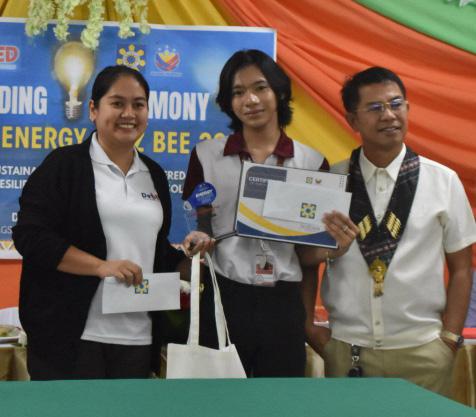
NSPC placer inspires young journalists
by ROHANNIE LAWIG
Asthe third placer of the National Schools Press Conference (NSPC), behind the triumphant rise of Sherlien Conejero, is the perseverance and the strong influence of a supportive mentor. Her story, however, was not straightforward. Rather, it has been a road of reluctance transformed into a come-from-behind victory.
Last year, Conejero finished third in the NSPC. This year, she sets her sights higher, buoyed by that experience and the confidence she had gained from winning first place in the DSPC. This was a victory of a different kind, as it marked a resounding return to the national stage after her previous achievement.
Conejero did not start out as a photojournalist. “Actually, wala gyud ko’y interest nga muapil ani,” she confessed, recalling her initial apprehension in Grade 6. It was her adviser, Ma’am Merlyn, who recognized a hidden talent and gently nudged her towards the world of photography.
The early days were challenging, filled with self-doubt and tears. “Nihilak pa ko adto na time, kay gusto na lage ko muundang, pero nakitaan man gyud ko niya [Ma’am Merlyn],” Conejero shared.

From a beginner to an NSPC 3rd placer, something I didn’t expect...
Booth designs, offerings, and stage introductions highlighted the diverse interests and talents of the student body, while the fair, including the opening ceremony and group yell performances, reflected the enthusiasm and unity of the student organizations.
“I cherish this memory, as it was an opportunity to provide value to the high school experience of everyone involved,” Kwek shared a personal sentiment, reflecting on the experience.
The 2024 Org Fair wrapped up with a resounding success, spotlighting the vibrant student organizations through their engaging booths, interactive activities, and lively performances—leaving a memorable mark on the entire school community and fostering a stronger sense of unity and involovement.
The promise of an airplane ride, a seemingly small incentive, served as a powerful motivator for the young photographer. It fueled her dedication through countless hours of practice, the pressure of competitions, and the inevitable disappointments along the way.
Conejero’s perspective on these setbacks is remarkably mature. She views them not as failures, but as invaluable learning experiences, crucial stepping stones on her path to success.
Conejero’s advice to aspiring photojournalists is simple yet profound: embrace the challenges. “Don’t fear the pressure, and embrace challenges,” she urges. “Just remember, the best work often comes after facing challenges.”
This philosophy, born from her own experiences, resonates with the grit and determination that propelled her to the national stage.
It is a story of perseverance, a testament to the potential that is unlocked when talent meets encouragement. From being an unwilling participant to national champion, Conejero’s story is inspiring to anyone striving for excellence and reminds us that often the greatest victories are born out of overcoming our greatest doubts.
Conejero’s success is not just a personal triumph; it’s a shining example for aspiring journalists everywhere. Now she is making a comeback to reclaim a higher seat in the throne of NSPC.
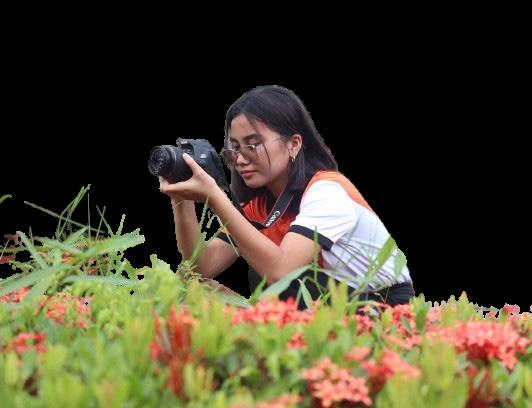
SILVER LINING Abuton, with coach, poses during the awarding of the Mindanao-wide Energy Contest.
Photo by Zacque Abuton
SHOTS OF A CHAMP. Sherlien Conejero, NSPC 3rd placer shoots in action, showing her dedication and skill to shine through for her next journey.
Photo by PAULA TAGUBAR
by CHRISTIAN ANGELO PASTRANO
FAILED SPARKS. Panic erupts as fireworks malfunction during Oroquieta City’s Christmas display.
Photo by: LHORD KIAN PIALAGO
Teen Pregnancy: The Cost Behind the ‘Blessing’ Narrative
In a fast-paced world, we often find teenage moms at a standstill. Our generation of neglect breeds unsupervised teenagers with no control and has concerningly tolerated this. The idea is that once a life sprouts inside a teen, her future is dead in a baby’s heartbeat. It is true to some extent, so why are we normalizing teenage pregnancies when we know the risks? This approach is actively instilling harmful values and mindsets in teens, and we are undeniably accountable for the consequences.
We should avoid sugarcoating teenage motherhood. Yes, babies are a blessing, but not when they risk ruining a future, especially when that is the stigma society has built around adolescent moms. It’s believed that teen pregnancy is not a deliberate choice. It is a consequence of curiosity and ignorance. However, this belief has shifted dramatically because our supposed sexually educated world has not prevented teenagers from acting hastily. Instead, we find the casual and unstructured manner in which sexual behavior is treated, especially among teens, to be the main cause of early childbirth.
Teen moms often face harsh realities too late, as shared by a 15-year-old mom from Misamis Occidental National High School (MONHS), that she was scared and having difficulty
coping when she found out. Oversimplifying teenage pregnancy as a blessing is dangerous and irresponsible as it romanticizes a devastating situation. It also hinders education, limits career opportunities, and further contributes to the current poverty conditions in the Philippines.
Despite collective efforts, MONHS reported 4 cases from 2024 to 2025. Can we still say our youth is uneducated when government agencies already established various measures? Laws like the Responsible Parenthood and Reproductive Health Act of 2012 (RH Act) and the building of the MONHS Teen Center aim to support sex education. Still, without cooperation and understanding from the students, then it would be useless. They lack discipline and are blindly ignoring the future for just temporary
pleasure.
“Support pregnant teens, not teenage pregnancy,” reflects our stand. Teenage pregnancy persists despite advocacy because true change requires a shift in the youth’s mindset. While external factors like inadequate education systems and cultural taboos play a role, it’s undeniable that many deliberately ignore the knowledge readily available to them, leading to avoidable lifealtering outcomes.
We must begin with early at-home guidance from parents and, under the Adolescent Pregnancy Prevention Bill (HB 8910), equip teenagers with the knowledge and resources to make informed decisions about sexual and reproductive health. Encouraging open discussions can help shape healthier perspectives on sexual behavior and help avoid impulsive and unsure decisions.

LETTERS TO THE EDITORS



WHAT HAPPENED TO INNOCENCE?
I
by HEINRICH TAGYUBON

’ve seen firsthand how easy it is for teens to stumble into a world they’re not ready for. My friend, when he was only 13, admitted he found his way onto Pornhub, a leading online adult entertainment platform, with no barriers, no warnings, no verification. This isn’t some rare mistake; it’s a failure to protect young minds. Explicit sites are for adults, and there is little to no effort to stop minors from accessing their content just to make a profit.
The damage is real. Research by the Institute of Family Studies shows that early exposure to pornography can warp a teen’s understanding of relationships, promoting unrealistic expectations and dangerous ideas about intimacy and consent. What’s worse, these sites profit from addiction, pulling kids deeper into content they should never encounter at that age. We are failing an entire generation if we let this slide.
Social media isn’t any better. Instagram, TikTok, and Facebook, platforms meant for connection, have become arenas for thirst traps—provocative posts designed to lure attention. Teenagers are posting sexualized pictures to get likes, comments and validation on social media, trying to turn their self worth into a popularity contest. It’s a disturbing shift, because now, social acceptance depends on how much skin you show. This opens opportunities for predators, groomers and pedophiles on the internet to prey on to children.
The platforms know exactly what they’re doing. Algorithms push this kind of content because it drives engagement and profits. Instead of protecting young users,
they fuel toxic cycles of comparison, insecurity, and exploitation. This is exploitation disguised as entertainment which we cannot stay silent for.
We need to wake up. Parents and teachers need to have conversations with teens on the dangers that lurk behind screens while simultaneously continuing conversations around respect, consent and self worth. If a kid doesn’t hear these discussions, they will be defenseless towards what they see online.
Lawmakers must step in, too. Right now, we need stronger age restrictions on porn sites and tighter moderation of social media; or better yet, implement banning. These platforms won’t change unless forced to, and they need to be held accountable now.
It is our duty to act now so we don’t owe that to the next generation. This is not something that can fester. Protective barrier must be made around our young ones. Stronger safeguards must be created, and a culture of respect must be built. Now, let’s join to make certain our youth can flower with dignity and hope, away from harm. I, myself, deeply loath this culture of indecency and sexualization.
Freedom Wall Gone Wrong
TSA Victims Silenced Screams
by MARNEL KEISHA CABURAL

Iby LARA ARAÑAS

he famed Misamis Occidental National High School (MONHS) Freedom Wall quickly became unpopular. What was supposed to be a page for unsaid thoughts and feelings, became a breeding ground for drama and disputes. Giving teens the ability to send any and all messages with little to no filters while remaining anonymous is just a disaster waiting to happen.
The Freedom Wall is yet another reason why parents should be informed of their children’s online activities. This is merely the consequences of their lack of backbone which enabled unethical behavior.
Justifying your child’s behavior is not good parenting. Being young should not have to mean being unable to take accountability for their demeanors.
As of now, the UNICEF’s latest national data show
that cyberviolence affects almost half of children aged 13-17. The advancement in technology spiked a rise in the youth’s online presence. This makes it all the more important for adults to supervise their children to be aware of what they may encounter on the internet.
In addition to that, multiple posts on the MONHS Freedom Wall violate the RA 10173 or the Data Privacy Act of 2012. The posts submitted range from stolen shots of

other students to exposing the dark truths about certain individuals. The moderator of the page should’ve been more strict with reviewing the submissions, as bearing the name of the school would mean bearing greater responsibilities, seeing the hostile environment this page has made paints our school in a bad light.
In response to the malicious posts, the school asked for the page to be taken down when the
situations escalated to the point of defaming one of their teachers.
I believe that though it may be the right course of action to take, the situation wouldn’t even have gotten to that point had they taken action sooner.
Even though some posts only intended to profess their love anonymously, it’s important to keep in mind that positive intentions do not always elicit positive reactions.

t’s not new for me to hear “don’t wander around at night” or “don’t wear anything revealing” as a persistent warning of the dangers lurking. I thought it was stupid to limit someone just because of our twisted society. Not until I experienced it firsthand did I realize the scary truth of being sexually harassed, which most people notice but choose to overlook. Sexual abuse is a constant reminder that whoever, whenever, and wherever you are, you are vulnerable.
Catcalling and other forms of sexual harassment are things I’ve been told to just shrug off because people are “predatory and manipulative by nature”. In the past, I’ve experienced being harassed by someone I trusted and looked up to. The image of him caressing my thighs and parts of my body as I sat on his lap, all while he planted kisses all over my face is something I committed to memory. Of course, as a second grader, I sat still in discomfort while thinking, “This is normal, right?” It wasn’t. I felt helpless as people told me that no matter what you wear or do, it’s your fault that you attract abusers. This crooked mindset is how people turn a blind eye to the cruel reality we face.
A UN Women study revealed that 7 out of 10 girls aged 12-17, and 9 out of 10 women aged 18-24 reported experiencing harassment. They were blamed by the public because they should’ve worn “decent clothes” and “they asked for it”. For what? For their rights to be violated? The abuser is always at fault. We need to break free from this victim-blaming mindset that leads victims to feel alone and scared causing fatalities. Sexual abuse is prevalent but unchecked. I say it is not a mistake but a choice. A UN Women’s study found that 70% of sexual abusers have committed multiple offenses, often against different victims. Moreover, there’s an undeniable barrier between victims and the justice system where the conviction rate for sexual abuse cases is estimated to be around 18-20%. It’s alarming how our society today is still unaware and incapable.
Protection isn’t about changing yourself but about ensuring no one violates your basic human rights. While changing predatory mindsets may seem unlikely, change can begin with us. We must not let others trample on our dignity. Our voices need to be heard because it is not our fault.
Getting rid of the toxic, victim-blaming mindset is a start, and strengthening the legal system by having specific courts with increased monitoring will ensure just rulings. We should practice defending ourselves against predators and fight for a safer environment.

Catcalling is an overt act of sexualizing individuals, and it occurs both in public and private spaces. This behavior encompasses actions such as whistling at someone or delivering backhanded compliments, all of which are completely unacceptable. Such actions endanger the safety and well-being of our environments and must be challenged and condemned.
-Shannaiah David, Grade 11-Einstein
Break the Chain: Confronting the Generational Curse
by ALFEIYA OMANDAM

As I observe the world around me, I am compelled to confront a stark truth: Our society is a dysfunctional family that we become a part of, and damage way beyond the walls of it. Is our community ready to condone yet another cycle of this? It was at the Philippine Research Health Registry that we saw the deep interrelationship between familial dysfunction and mental health problems, but we persistently stay in silence that serves no one.
In a broken home, kids learn that chaos is normal. Instead, it fosters emotional suppression and provides families with covering up their struggles and carrying on as if nothing is wrong. This silence is made to feel like a prison to a generation, because they have the pain of feelings they’ve never expressed to but never escape. I am not going to turn my head away from this reality that is calling out for attention. We need to tackle the stigma that has held us bound,
hiding behind shame in mental health issues. Time and time again by saying no to these struggles, we are strengthening barriers, denying families the help they need. Alarming rates of anxiety and depression are seen according to the Philippine Research Health Registry, which we cannot ignore. If we don’t call out cultural norms, how can we rethink dysfunction? Now is the right time to break down those toxic family dynamics. I find peace with
open communication as well as a space to be heard without fear of judgment. It is time to cultivate environments where asking for help is courageous and is celebrated from a place of mental health. I imagine community support systems that empower people in the throes of familiar challenges. We make families trapped in pain break barriers when we advocate for more access to mental health resources and when we build networks of understanding.
Acknowledgment and action lead to the journey of healing. Are we going to meet these challenges with the strength and the determination to overcome them? Hence, it is time for change that we ought to begin in our homes. It is the moment to shatter both the cycle and the silence of suffering that torment us. Moreover, the community must do this together to light the way toward healthier families, which will lead to a resilient society where everyone can be safe.

Silence breeds pain, and dysfunction thrives in its shadow. It’s time to break the cycle, confront stigma, and build a society where families heal together.
BULLETIN BEAT
by ALFEIYA OMANDAM

Many schools are prone to road traffic injuries because of the unsafe walking environment and dangerous locations. Traffic regulations are instilled to mediate the predicaments faced on the road ensuring the safety of the learners. However, what if the regulation seems like a facade only for a star-studded appeal to the public?
For almost half a decade of promenading to school as a means of transportation, I witnessed traffic enforcers maintaining the smooth transportation flow at school zones during morning and afternoon class dismissal. While they have done it successfully, at times, the regulation seems to be more of irresponsible service.
Every year, more than 1.3 million people die in road traffic crashes worldwide. Leading 8th on the chart, road traffic crashes are the cause of death for people of all ages, and the leading cause of death for children and young adults. And more than half of all road traffic deaths are among vulnerable road users, which include pedestrians, cyclists, and motorcycle riders.
Data from the Philippine Statistics Authority (PSA) indicate that road traffic deaths increased by 39% from 7,938 deaths in 2011 to 11,096 deaths in 2021. Road traffic injuries are the leading cause of death among Filipinos 15-29 years old, and a major killer among children.
Road traffic injuries are a major problem yet overlooked by the public. Deaths and injuries from road crashes are preventable, and all sectors have roles to play in promoting road safety. People responsible for safety on the road should be on standby, focusing on learners that need assistance on the road; maintaining their proper duty for there lies the safety and lives of the learners at school.
Road regulation is a job that ought to be held with responsibility and pure dedication to the frontlines on the road. And purely not a mere facade to the public that they’re doing the “job” on the road because lives are at stake. Ergo, safety is a responsibility not only to a few but an exercise to everyone on the road where lives are on the frontline.

Road safety isn’t a performance; it’s a responsibility. Regulations must protect lives, not serve as empty gestures for public appeal.
The Final Solution Toward Life
Sby HEINRICH TAGYUBON


adly, the act of taking one’s own life nowadays is increasingly common. They are simple and must have roots in the pain and chaos of being a human being in this age. For many, life has been described as a precious gift, but for others, the pressure from society makes it unbearable as if it was a curse. This is a growing problem that serves as a stark reminder of a world in flux, keeping up with the wrong end of the stick when it comes to fixing the mental health crisis that grips so many people.
The World Health Organization reported that the global rates of suicide are on the rise every year. With the development of science, technology, and the infrastructure of the world, challenges increase vastly for people. I observe economic instability, social isolation, the economic and social pressure of modern life as a storm for mental health struggles all over the world.
Many were brought upon this world full of hardships and doubt. Some are born who are struggling financially while some are born with horrible people. As they grow older, they constantly bear the scars that have been set upon them. How sad isn’t it? But, why aren’t you and everyone doing anything about it? It is because the world is also selfish. Many people appear when a person has decided to end it all while they weep and regret, but when they were alive, they were treated like rubbish. In fact, some may even have caused the taking of one’s self;
The one who took who only wished for love.
While this chaos is still going on, there is still hope. I wish for a world of love, peace, and joy, where people like to live in. I vision on what humanity could accomplish if society prioritizes kindness, compassion and support. To achieve that ideal, there should be an effort to deal with the underlying causes of suicide.
Beyond this, productivity is improved when societal pressures are reduced, and a focus on individual wellbeing encourages a sense of community and belongingness. Everyone— governments, organizations, and individuals alike—shall play a role in creating the experience of happiness, making it not a luxury, but something all can share and enjoy. I believe by working together, society can strive toward a future where pain and despair are replaced with hope, healing, and collective peace.
Bias for Beauty

Suicide is a cry for help the world often hears too late. It’s time to replace indifference with compassion and build a society where hope thrives over despair.
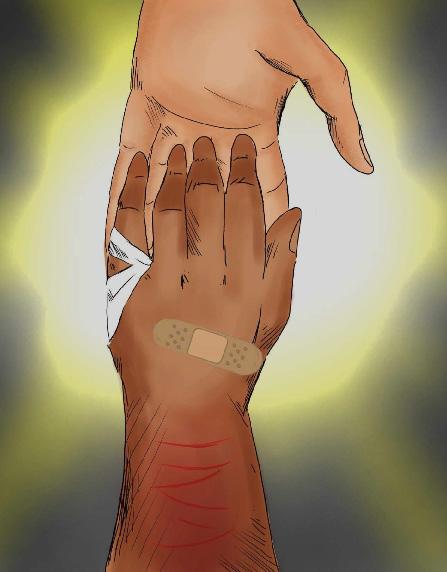
by LYLA RAFAELA LEOPOLDO

In Philippine elections, voters often prioritize optics over substance, selecting candidates based on charisma, appearance, or media appeal rather than qualifications or track records. Personality politics dominate, sidelining capable candidates who lack resources for polished public images. This undermines the integrity of the electoral process and sets a poor example for future voters like me.
I often hear frustration about the lack of qualified leaders, in discussions with my peers, especially when media-savvy figures dominate elections. It makes me question whether our votes can truly bring about meaningful change if we continue to reward charm over competence. As I approach my own future as a voter, I worry that these superficial factors will continue to influence leadership choices, leaving the country led by individuals who lack the necessary experience

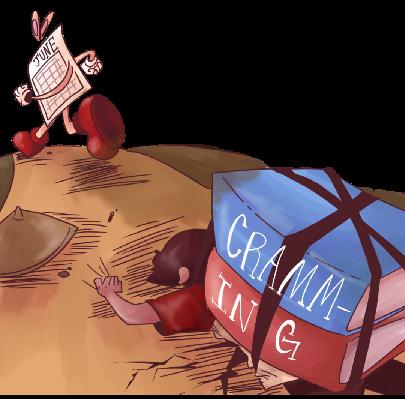
and skills.
Studies show that many voters prioritize media appeal and personality over qualifications. The Philippine Center for Investigative Journalism (PCIJ) highlights how political campaigns often focus on creating relatable public personas rather than presenting solid policies, which fosters a shallow political landscape where popularity becomes more important than the ability to govern effectively. Moreover, data from
COMELEC also shows that media exposure and pre-existing fame help candidates like showbiz personalities perform well in elections, despite their limited governance experience. It’s almost as if voters are asking for ineffective leadership that will fail to tackle the country’s most pressing challenges.
To conclude, I believe that electing leaders based on superficial qualities undermines democracy and slows national development.
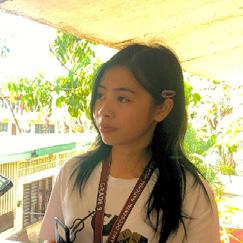
This trend risks perpetuating ineffective governance and fostering a culture where style outweighs competence. Voter education programs are crucial, focusing on how to evaluate candidates’ platforms critically. Media outlets must also prioritize substance over sensationalism., promoting informed decision-making. As a future voter, I believe my generation can reshape the electoral process by valuing competence and integrity in leadership.

Rushed Lessons to Crushed Learning
by MARJE CHRISSEN SALIG


The school year is now compressed to end by around April in an effort to start classes next school year sooner, which results in rushed classes and a hurried academic calendar. Schools are pushed to finish the syllabus quickly, which places unnecessary pressure on students like me.
I believe that this rushed approach is detrimental to the quality of education and the well-being of everyone involved. The school year should not feel like it’s being crammed into a shorter time frame just to meet arbitrary deadlines.
I know of schoolmates who traveled long distances to get home for the holidays and had to return on New Year’s Day just to make it to class on the 2nd.
The constant pressure to catch up affects not only our understanding of the material but also our overall well-being. Additionally, the rushed school year results in burnout for teachers as well, as they are forced to rush through lessons without the flexibility to adapt to student needs. This hurried pace undermines meaningful engagement, and the rushed activities often feel like mere formalities rather than opportunities to truly test our understanding.
The pressure to finish the school year early and the rushed return to
classes after the holidays disrupts our academic performance and well-being. It compromises the depth of learning, increases stress, and undermines the purpose of education itself.
I suggest that schools adopt a more reasonable academic calendar, allowing for a less rushed approach. By extending the school year slightly and making the change more gradual, schools can offer a more manageable pace, providing adequate time for learning and ensuring a better, less stressful academic experience for all students, tachers and families alike.

Stranded by my Strand
Cby NICOL KEITH MAGHUYOP

hoose STEM! This is what they say. Well, I’m glad I did. I was strand-struck, you see. To see is to believe, and to experience is to realize. College is just up ahead, and the opportunities are walking beside me, yet I look behind me to see how other strands race without equal opportunities. Thus, I come to realize that while the opportunity is served to me, others have to ask for it. So, would you rather walk with me? Or sweat against me?
The Department of Science and Technology (DOST) seeks to prioritize authorizing STEM learners’ eligibility to benefit from their scholarships entirely, while non-STEM strands will have to burn their minds up to rightfully claim their spot in the top five percent of the graduating class. So, who are you if you aren’t at the top? Would you be able to blame the system, though, when the prioritized programs are undergraduates of bachelor of sciences?
Moreover, your passion for your strand would not poetically
justify your knowledge capacity to pass certain college entrance exams. Supposedly, these exams are to measure your qualification for higher learning through trivia of your knowledge capacity of general knowledge. Yet, as a once and only once examinee of UPCAT, I can attest to the difference between general knowledge and emphasizing the competencies convenient for my strand—STEM, which puts me one step ahead of other strands. Hence, would you shed
Microscope Misses its Focus
blood for your passion or lead in an easier direction?
Now, would you sacrifice your dreams or would you let the opportunity pass? The decision is always ours.
Research claims that 39% shows course mismatches from our tracks or strands taken during our senior high school years, alongside, being pressured by family and peers to usher a path of course mismatch. Hence, we dissociate our pursuit of a career from our chosen guidance, leaving some of us struggling to acquire
They say that beauty is in the eye of the beholder, but did this microscope forget to wear its lenses today? The lab report is as vague as my experience with my first ever contact with a microscope. Surprise! It both happened on the same day and in the same activity. Moreover, more lab activities are hasting against our competencies, yet the equipment is still outdated. It needs to be upgraded!
Disparities in school resources are a pressing challenge to the educational crisis topping the country’s predicament nowadays. The lack of updated equipment and textbooks and the inability to access resources compromise the educational quality, particularly in remote areas where there is an absence of innovation. This inability promotes inequality in learning, fostering ignorance and low quality of education.
In an interview with a Biology teacher, she expresses alarmingly the low quality of reliability of generated lab results and tests from inaccessible innovative lab instruments. From fragile coverslips and slides, the process returns to start. Moreover, it doesn’t achieve the highlight of the activity: cell structure, since what you can only see is the exterior of the cell, and not the complex system internally.
Furthermore, as my school continues to face the absence of established lab tools, other facilities struggle with how to use all available
equipment before its shelf-life. According to a report on May 12, 2024, approximately 70 million worth of lab equipment is unused and stored away as listed by the Commission on Audit (COA). Isn’t the contrast contrasting? Biology—my dream course, is just as blurry as the magnification of the microscope I recently used. It doesn’t justify the equity of learning I get to have from the school’s inability to supplement the apparatus necessary for my growth. It is without a doubt that this system of education truly lacks in all aspects: quality learning, innovative technologies, etc. Hence, as a columnist of this publication, I deeply urge an appeal to fund the upgrade of laboratory equipment to maximize the accessibility of lab resources. Also, I encourage a shared collaboration between the COA and the Department of Education (DepEd) to allocate some unused equipment to certain school facilities facing the adversity of technological innovation.
Privilege exists in Elections?

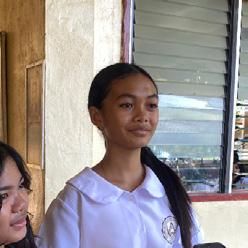
I saw a future in Isaw
Scholarships for Futures, Not Furtunes
by LYLA RAFAELA LEOPOLDO
scholarships to ease future financial burdens. So what is it gonna be, your dreams or your needs?
The system’s scholarship eligibility diversity, besides income qualification, must be revised to give equal prospects to fellow strands leading their passionate fire. More as well, I urge universities to perform like how it is defined to distribute equally wide-scoped general knowledge questions. Lastly, I suggest a time investment for career guidance and matching program activities for every SHS student.

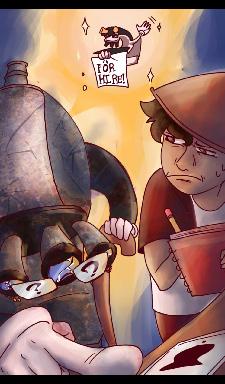

Outdated tools hinder quality education. It’s time to invest in modern lab equipment and bridge the gap in learning resources.
OUT OF
students in Misamis Occidental National High School agreed that they voted for someone because of their physical appearance.
by HEINRICH TAGYUBON

“Anong nakain mo at ang taas ng mga scores mo?” my classmates asked. I said, just streetfoods, darling! They looked at their iced coffees clutched in their hands and several strands of Isaw sticks from mine, a notion of financial status being irrelevant to a periphery of quality education.
According to Philstar, typical Filipinos receive daily allowances of at most 50 pesos from their parents to cover lunch, tricycle fares, school monetary contributions, etc. This seems unfortunately humbling for some, as students vouch for streetfoods to fill their stomachs from loose changes from their pockets. For us, it doesn’t just suffice our hunger but also our dreams. Hence, streedfoods aren’t just for the convenience, but our survival. Moreover, the all-time “streetfoods is bad for your health”
cliche remains an occasional scare. How many times was this chicken reheated? Hasn’t this sauce already been mixed with dust? Is this still safe to consume? It’s not always rainbows and butterflies for us streedfood-consumers. It’s a mere definition of how our financial status limits the option of our nutritional food consumption.
Hence, streetfood vendors proclaims to be the unsung heroes of broke students like me, a person who doesn’t live the luxury of food elegance, but resides on the streetfood life. But
hey, at least someday I’d get to say, “I graduated on a diet of Isaw with a side of Buko juice”.
All in all, as a proud columnist of this publication, I urge each admin member and head of this school faculty to minimize the price range of cafeteria meals. Moreover, I also strongly urge a healthy street food stalls partnership from governmental agency such as the Department of Health (DOH). Lastly, for the school ministry to acknowledge the use of meal vouchers for students with low-income to use.

The city scholarship grant at MONHS has highlighted a key issue in the Philippines today: the growing divide between the bourgeoisie and the working class. Scholarships, designed to alleviate financial burdens, often end up benefiting those who are already financially secure, leaving students from poorer backgrounds at a disadvantage.
I believe scholarships should be awarded based on genuine need, not to students from privileged, bourgeois families. The current system disproportionately favors comfortable students, reinforcing the class divide in Philippine society.
I know of many students who come from lower-income families faced significant barriers during the application process— whether it’s time constraints or lack of resources. Meanwhile, students from bourgeois backgrounds, who have access to financial stability and—conveniently—more free time, were able to secure funding.
One of my acquaintances, whom I can guarantee lives comfortably, secured a city scholarship slot when it could’ve gone to someone in desperate need. This dynamic reflects the broader inequality in the Philippines, where the bourgeoisie continue to control economic opportunities, while the working class struggles to break free from poverty.
The current scholarship process, as it stands, reinforces the socio-economic divide. Instead of providing equal access to education, it perpetuates the dominance of the bourgeoisie by favoring those already in a position of privilege, leaving the proletariat behind.
To address this, I believe the administration should adopt a needs-based scholarship system. By evaluating each student’s financial background and personal challenges, we can ensure that scholarships go to those who need them the most. This approach would help bridge the gap between the bourgeoisie and the working class, fostering a more equitable educational system that serves all students, regardless of their socio-economic status.

Scholarships should help those who don’t have much, not take away from them.

OUT OF 30 PARTICIPANTS preferred eating street foods due to high prices in the school’s canteen.
by ALFEIYA OMANDAM
CAMPUS CATCH
PULSE POINT
I miss our time together, but knowing you are in a better place, I’m still grateful because you aren’t hurting anymore.‘Til we meet again,Jill.
THE RIFFLE EFFECT
One Child’s Legacy, One School’s Change
by ROHANNIE LAWIG
The once spotless chair is now covered by dust, a fleeting reminder of memories that will never fade but will always remain, even if hidden beneath the dust of time.
A friend, a daughter, a ray of sunshine—that’s what people called this young angel, Jillian, who is now shining brighter than ever, wherever she may be. No one could have imagined such a tragic end for this little girl, whose cheerful personality could brighten even the dreariest day.
She smiled like a summer sunrise; she laughed like a happy breeze. Jillian wasn’t just a nice person—she was kind. Every quality she embodied flowed from her like a gentle river, smoothing the ever-ragged rocks of the world as it passed. Her classroom, always spotless, reflected the peace she carried inside. With effortless grace, Jillian saw into the hearts of others, offering comfort and understanding. Her humor was a gift, wrapping everyone she met in love and support.
But one day, the light of her presence dimmed forever. Jillian’s spark was extinguished in a tragedy that shattered everyone who knew her—she took her own life inside the school. The world seemed darker, emptier, and filled with questions that would never be fully answered.


Her absence, though heartbreaking, ignited a fire of change. Those who loved Jillian remembered her kindness, her exuberance, and her light, and they vowed to create a world where every child could experience the love, support, and understanding Jillian had so freely given.
A new chapter began with the introduction of the Matatag Curriculum. The school community banded together, determined to ensure that no student would ever feel so alone again. They initiated lessons on emotional well-being and encouraged open conversations about mental health. Counseling services became more accessible, with students able to share their feelings anonymously online or in face-to-face, judgment-free sessions with caring counselors. The school transformed into a sanctuary—a safe space where every voice was heard, and every heart was valued.
Creative outlets like writing, drama, art, and music were integrated into the school day, giving students the tools to express their emotions in healthy, constructive ways. Mindfulness exercises and stress-reduction techniques became part of the routine, helping students learn how to manage their feelings. This wasn’t just about solving
A STAR STILL SHINING
Finding Hope Amidst Christmas Grief
by ABEGAIL SHANE BACO
As the holiday season unfolds and homes in our community are decorated with twinkling lights, one family sits at the intersection of joy and sorrow. This Christmas, they’re enduring a bittersweet season, forever transformed by the loss of their dear mother, their North Star. She is their beloved, the flame that once illuminated the expanse of their universe, a universe now darkened by her death. This family’s tale touches our hearts as a parish, because we gather in our town with families to share traditions. Their mother was more than a parent she was the heart of their home, a source of energy and love whose laughter could banish even the darkest days.

Photos of her infectious giggle and bright eyes are painful reminders of the joy she brought to their lives. But in the aftermath of her death, the bright spirit of Christmas seems stifled.
The celebrations that once overflowed with excitement are now filled with a bittersweet sense of melancholy as the family mourns. The metaphor of a star fading is not poetry for them, it is a reality they grapple with every day.
The light of what once made this season a celebration has faded, leaving only a reminder of what they cannot put into words what they have lost. But in the midst of their grief, this family knows the recovery of their faith that out of the ashes of grief, a star can rise.
They understand on a deep level that the cycle of life is full of endings that lead into new beginnings. Their grief is not
an isolation, it is a communion that unites them further This Christmas, they celebrate the memories of their mother and transform their grief into a celebration of her legacy that endures.
Turn it into the ornament that hung on the tree and the photograph that was shared and the story the storyteller told as the twinkling light led their eyes through the darkness. They grow their memories like jewels, tend to the love that endures, and fill the sky with constellations of events shared that keep her fire burning.
Thus, their indignation turns into a common glow-proof of family strength, proof of love endurance. When they find themselves sitting around the tree, they know that even in the direst depths of heartache, the vision of a new day lies just beyond the horizon. While we

rejoice in the light this holiday season, let us also pause to remember those who carry the burden of loss.
There are many families in our community going through similar experiences, drawing comfort from treasured memories as they cling to the hope that better days will come.” These stories serve as a testament to the limitless strength of the human spirit and the unbreakable ties of family. This Christmas, let us remember those whose light has gone dim but whose love will forever remain bright in our hearts. Among our celebrations, we can find ways to help each other so we each have someone to share our sorrow with. But in our observance, we can forge a new legacy of love, hope, and remembrance- lighting the way for others traveling the same path.

-Samantha Sasti Gonzales (Jillian’s close friend)


FUTURE SHORT-CIRCUITED Dreams vanish in a snap while chasing them
by ABEGAIL SHANE BACO
required tools and materials, Joshua took on part-time jobs, balancing his schoolwork with his job responsibilities. His perseverance and work ethic were admired by those around him, his determination to make his dreams a reality, despite the hurdles, was an inspiration to many Joshua’s guardian, who cared deeply for him, spoke of him with great affection, describing him as a kindhearted young man with enormous potential. Though Joshua was somewhat reserved by nature, his guardian noted that his character and hardworking attitude were the traits that stood out the most. Those who knew him were confident that Joshua had a bright future ahead of him, one that would surely be marked by success.
However, Joshua’s promising future was tragically cut short during a routine Electrical Installation and Maintenance (EIM) class. On that fateful day, Joshua and his classmates were assigned to a wiring task, as with any hands-on project in a technical field, there was an inherent level of pressure to get things right, and the students were focused on completing the task at hand. Unfortunately, in the midst of their work, Joshua accidentally held onto a clip-on without turning off the main breaker that supplied the classroom with 220 volts of electricity.
The powerful current surged through his body, the shock of the high voltage caused Joshua to lose control, and he was unable to release his grip in time. His
classmates, horrified by what had happened, quickly rushed to turn off the main breaker, hoping to save him. But in less than 10 seconds Joshua collapsed immediately, his body unresponsive to their efforts to help. His pulse faded as they tried desperately to assist him, but tragically, Joshua passed away before reaching the hospital.
The loss of Joshua is not just a personal tragedy for his family and friends but also a reminder of the risks involved in hands-on fields like Industrial Arts. While these fields offer immense opportunities for creativity and skill development, they also require caution, respect for safety protocols, and awareness of the dangers inherent in the work. Joshua’s untimely death serves as a sobering reminder that such fields, though rewarding, come with risks that must always be taken seriously.
Despite this heartbreaking accident, Joshua’s legacy will live on. His story serves as a reminder that pursuing one’s dreams requires both dedication and sacrifice, and Joshua’s journey showed that he was more than willing to put in both. His hard work, his kindness. And his genuine love for Industrial Arts will continue to inspire all who knew him.
Though his life was tragically cut short, Joshua’s legacy as a hardworking and passionate individual will continue to inspire those who remember him. Joshua Maravillas may no longer be with us, but his influence and memory will never fade.
“
School days are different without you, Josh. I never expected such thing to happen on that day, but God must have a reason for that. Hope you’re doing well up there.
-Jason Gomez (Joshua’s Classmate)
A SHINING STAR TOO SOON EXTINGUISHED
by ROHANNIE LAWIG

eisha. The very name brings to mind a vivid picture of a whirlwind of energy, an unyielding drive for success, and a heart full of love. A younger sister, gone too soon at the tender age of 14, leaves behind a legacy that still inspires and breaks our hearts all at once.
Keisha’s passion burned bright. She had an unyielding ambition, a work ethic that never tired, which fueled her dreams. While she did excellently in academics, finding joy in the challenge of high grades and the pride she brought our family, her free time was filled with simple pleasures— mobile games, a testament to her balanced spirit. The most special of those memories would have to be
the countless nights filled with deep conversations, with bouts of laughter that would echo throughout our home, and the unwavering support between sisters. Moments full of intimacy and connection remain etched in my heart—a treasure trove of love and shared experiences. She was a lodestar, an inspiration to not just me, but to our siblings and cousins to strive for excellence in academics. Her high grades became a benchmark, a sign of what could be achieved through hard work and dedication.
Keisha was more than an excellent student; her personality shone through. She lit up every room, be it with her boisterous dance sessions or late-night routines. Her sparkling spirit was that ray of joy that left an inerasable mark on everyone she encountered.
Tragically, complications from blood cancer cut short Keisha’s life. Her sudden hospitalization showed that she had severe deficiencies in her platelets and hemoglobin—something that was realized a little too late. Her passing is a sobering reminder of the importance of balanced nutrition and preventive health measures. Perhaps if she had lived a healthier lifestyle, things might have been different. It is this painful truth that drives our determination to create awareness of cancer prevention and the importance of a balanced diet. During her illness, Keisha was surrounded by the unwavering support of our loving family, relatives, friends, and classmates, who provided constant moral support through daily visits to the ICU. The comprehensive medical care she

received was, though eventually inadequate, testimony to the love and dedication of those who took care of her.
In our darkest hour, the outpouring of support from Keisha’s school and our community was overwhelming. The kindness, financial assistance, emotional comfort, and spiritual guidance we received were remarkable. This generosity, this profound display of love, will forever be cherished and deeply appreciated. Thank you, MONHS, for your unwavering support. To God be all the glory. Keisha’s memory, though tinged with sorrow, shines brightly, a reminder of the beautiful life she lived and the lasting impact she had on all of us. She may be gone, but her spirit, her light, will forever sparkle in our hearts.

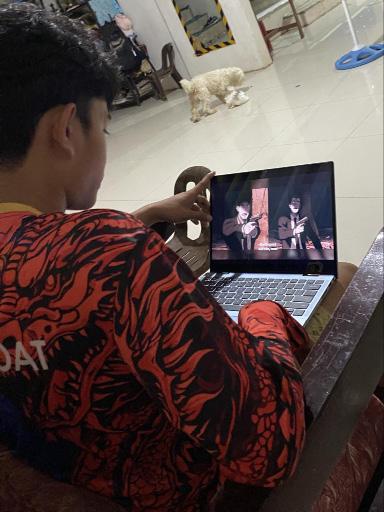
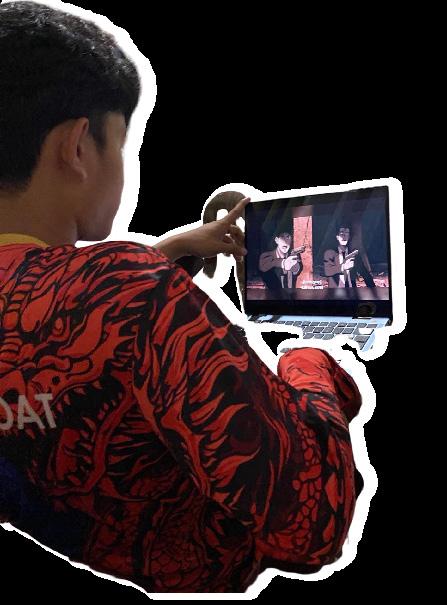
Drafts to Crafts
by ROHANNIE LAWIG
Ivan’s journey from being a layout artist for his school newspaper to becoming a freelance graphic designer has been one of dedication, collaboration, and a healthy measure of perseverance. His story, laced with challenges conquered and successes saluted, provides an interesting insight into the world of youth entrepreneurship.
Ivan’s experience with the school paper was not just about deadlines and design but was very much a formative experience that helped shape his career path. He remembers the tension of typesetting whole papers, the periods of inspiration drought, and the final victory of winning first place in the DSPC competition.
He enjoyed the stress of tight deadlines and realized the significance of teamwork during these experiences. The spirit of collaboration was key, especially when deadlines were tight.
As he mentioned, the two people who brought him and still aiding him to this adventure are his “day one coach”, Ms. Krisha, and his mentor, Kuya Kim, who taught him the importance of enjoying the ride and embracing the struggle. RSPC disqualification trained him with a sense of defeat and became the entryway to learning, more interested in opportunities. He found ways to transform disappointment into determination.
Ivan takes pride in all of his school paper projects, and notes the teamwork that contributed to their success. He is 100 percent grateful for the guidance and encouragement of his mentors, Ms. Krisha and Kuya Kim, who played vital roles in his growth as a layout artist, not just his technical expertise, but a confidence and a joy in his work, brought about by the mentorship. It is bonding people, and mentoring is never a new theme in Ivan’s story.
The experience Ivan had with the school paper ended up becoming a launching pad for his independent journalism career. Design hit him when passing between school and the

publication; so, it came down to layout as a freelance job. Understanding the niche area of layout design, he realized he could use his abilities to make some money and create a stable future for himself.
Making the leap from school paper to freelancer did not come without its challenges. Building a portfolio out of his school work, finding local (and online) clients, and finding the right balance between school and work was the first challenge. His experience of working on a school paper gave him the skills and confidence to meet these challenges head-on. It was particularly challenging to manage time and communicate with clients, which demanded much strategy and effort.
Ivan’s school paper work feels no different from freelance gigs. He means both with the same kind of intention and seriousness, seeing them as part of his overall career ambitions. Whether in good years or bad years, this dedication is his hallmark, and it demonstrates his professionalism.
Balancing school and freelance work necessitates meticulous time management and unyielding discipline. Ivan dedicates his weekends to his layout commissions, setting aside weekdays for his studies and prioritizing important deadlines. His disciplined strategy allows him to keep up good work in both areas, thus, ensuring academic success and client satisfaction. A key factor in his balance of his academic and professional commitments is his consistent approach, strong organizational skills, and a focus on producing high quality work.

COM-FUR-TING BOND
How One Teacher’s Love Brings Solace
by ACCEL JOHN P. MIRA
“A dog is a man’s best friend.”
A phrase that couldn’t be more true at Misamis Occidental National High School (MONHS), where a heartwarming story unfolds. Crisanta R. Batbat, one of the school’s cherished teacher who is not only known for teaching lessons but also bringing comfort to students through her love for stray dogs.
In the quiet hallways of MONHS, dogs gathered like an ant-like colony, resting and playing beside the walls. Their playful barks, soft murmurs and cuteness bring life inside the campus, creating an atmosphere of comfort. As students watch them, they often find themselves drawn to this amusing scene.
For years, Batbat has been a mother not only to her child but to the dogs, as well . Her bond with the stray dogs started in the 1990s when she first worked inside the school. After she saw these dogs wandering and striving for food, she was touched by their condition. She started
feeding them leftovers from the school canteen. Over time, she fell in love with the dogs as their loyalty towards her remained constant and untouched.
“Maluoy ko’g iro nga, kanang, wa’y kaon, dayon naa ma’y pagkaon sa canteen nga sobra, akong pangayoon dayon ituwa nako nila,” she shared.
The presence of these dogs made an absolute positive effect on the students. For many seeing Batbat surrounded by her furry companions offers a moment of calmness and entertainment amidst the pressures of being a student. As she walks through what seemed to be a valley of joy, her adorable
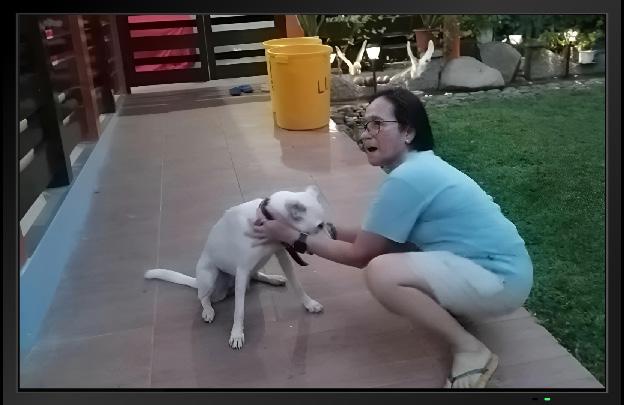
furry friends wiggle their tails in excitement. Like a worm wobbling, students often pause to pet the animals, finding peace in their gentle behaviour.
Batbat’s kindness and the dogs’ loyalty have turned stressful days into opportunities for connection and care. Students who might otherwise feel overwhelmed by academics or personal struggles find comfort in this unique companionship.
The simple joy of interacting with the dogs, watching them play, petting their soft fur, or even just seeing them nap peacefully creates a sense of serene.
Though the dogs have
since been removed from the campus, their impact remains. The bond they created with the students linger in the hearts of those who experienced the joy they brought.
Stray dogs are often misunderstood, but at MONHS, they became a unique support system to help relieve the inevitable stress and pressure students face.
Batbat’s compassion not only changed the lives of these dogs but also transformed the entire school into a more meaningful and welcoming environment. Batbat reminds us that love and comfort come from the most unexpected places.
by GODELIEVE BRIANNA R. NAONAO
Some struggles in life seem too overwhelming to overcome. Yet, when there is a will, then there’s surely a way—a determined worker in Oroquieta City’s Social Welfare and Development (CSWD), miss Junela De Ocampo, works diligently through her days and searches for light in the literal dark with her glaucoma, causing her total blindness. Nevertheless, she strives to make a success of herself and sets aside the stereotypes.
While losing a sense, especially one of sight is difficult, life pursues fairness and gifts Junela a firm resolve instead— one that certainly proves to be proficient as the girl has made astonishing achievements, even before becoming a social worker, despite her disability.
Despite being blind, Junela became a Social Welfare Assistant in Oroquieta, a rare achievement. At Misamis Occidental National High School, she excelled in the STEM strand, participated in DepEd’s Read-A-Thon contest, joined various clubs, and became a respected news writer. She later earned a Bachelor of Science in Social Work in Zamboanga, demonstrating remarkable determination and resilience.
Meanwhile, although she has received no particular medals or other forms of reward for these, Junela has also managed to teach herself valuable lessons and habits. Journeying independently to work everyday, she knows her way along and around
PRINCESS FAITH B. SANTAMINA
Oroquieta City; same goes for her workplace.
Junela also learned to speak up more, because even without any optical issues, some people still fail to notice some things sometimes, and she has to make it a routine to raise her voice a little more to be seen, or else she will be overshadowed and cut back from her desired destinations.
However, despite her determined efforts, there are still instances where she is seemingly inconvenienced by her disability, as she once deemed a ‘physical limitation’. She finds that some tasks in her daily life do need others’ assistance, and without help, she won’t be able to do much. For anyone, that will always inevitably bring a sense of hopelessness.
Junela perseveres despite her heavy heart, driven by her determination to create a brighter future for herself and others with disabilities. Supported by her family and friends, she embodies
resilience and selflessness, committed to addressing the challenges that lie ahead.
This shows that although some are physically unable, it does not immediately mean that they are incapacitated or farther behind other people in any aspect— they are strongready to soon sufficient to


Have you ever thought about what it truly takes to support a family under the scorching sun as a student? Amidst the triumphs we had in our existence, we always found time to share our winnings with our parents, whether our achievements were big or small. Our success is also theirs.
At the forefront of his chasing dreams, is Crizzander M. Bulawit, a determined grade 11 student at Misamis Occidental National High School (MONHS), whose hustle reflects his aspirations itself.
As he strolls through the bustling hallways while wearing a bandana, he carries a foam box filled with frozen confections and a plastic cylinder filled with many assorted candies. With each step, he sells candies and frozen treats. Beneath his determination lies a commitment to uplift his family’s financial instability and carve out an illuminated path ahead of him.


Throughout his journey, Crizzander shares that while living with his parents, he made a conscious effort to ease their financial burdens. Although he hasn’t faced major financial struggles himself, he still wants to help to show that he is grateful to his parents for raising him. He wants to give back, not only to ease their worries but also to honor the love and support they have shown him.
Crizzander faces numerous challenges as he navigates the dual roles of a dedicated student and a cafeteria creator. He balances his academic pursuits with the responsibilities of his work, all while meeting the expectations of his supervisor.
“My manager is my best friend and someone I trust, but he sometimes makes decisions without consulting me, which can be challenging, especially since I have ADHD and struggle with distractions and forgetfulness,” Crizzander voices out.
As Crizzander’s life and small business flourishes, he often finds himself throwing back on the
mischievous yet profound nature of existence. Each success was interwoven with a reminiscence of his parent’s unwavering love and support, which had shaped his journey.

Despite our heavy workloads, we never lose sight of the loved ones— parents and pets alike—who await our return. Family, in all its forms, inspires us. When we draw motivation from those we cherish, our work transforms into a joyful pursuit. This passion beams out, attracting countless customers eager to share in what we create.
Each candy sold and each frozen treat shared reflects not only his determination but also a deep appreciation for the family that has always been his cornerstone.
In the corridor of life, as he navigates the challenges ahead, Crizzander embodies the belief that with hard work, gratitude, and a little sweetness, he can carve out a path filled with promise and joy. Indeed, all the work with a side of play make Jack a bright boy.
FURRY FRIEND. Ma’am Batbat bonds with her beloved four-paw friend at the street.
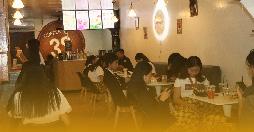
A BUZZY HIVE FOR STUDENTS
More than a coffee stop, a student sanctuary
STUDENTS CORNER. Students pack in the glimpse-of-Cebu cafe, looking for a treat and a break from studying.
‘Asanctuary of study and friends.’
The air in Sugbo Macciato’s Oroquieta branch hums with a low, soothing thrum — a blend of rich coffee aromas, quiet concentration, and the rhythmic tap-tap-tap of keyboards.
It’s a cacophony of productivity, an incidental soundtrack to the academic lives of the students who call this café home.
It’s more than just a coffee shop; it’s an ecosystem, a carefully curated environment where learning and community thrive. It’s a testament to the power of design that a space not only be beautiful but contribute to a thriving community. Think about a bustling beehive, where each bee has its task but also a place to go for comfort and reassurance in the crowd. Think of Cebu, a place where buzz and quiet, industry and vacation meet.
Sugbo Macciato Oroquieta is no different. It is strategically situated right in the middle of the academic districts of Oroquieta, making it a natural gathering place for students trying to escape the rigors of study. Whether you’re alone or with others, the café’s warm atmosphere — with just the right amount of comfortable chairs, natural light, and efficient layout — invite you to hang out to study.
Students sit studiously in lab coats as if they were worker bees, reading their textbooks, making laptops light up as they search for knowledge and discuss with each other, buzzing away like bees. Even in the busy buzz, this café is a testament to your study style: the ability to find a quiet contemplative corner, or to be in the drone like bee huddle of studies.
Aside from the aesthetically pleasing design, Sugbo Macciato Oroquieta also offers various practical, student-friendly services that cater to its studying customers. Wi-Fi, the backbone of the digital world we live in, keeps connectivity seamless for research or tasks. Scattered power outlets throughout the café take away the constant fear of battery-life running out, an enemy of ever-scientific progress.
The menu which I had the pleasure of composing is an affordable selection of drinks and snacks created to fuel late-night study sessions and provide an energy boost between classes. It’s a pit stop for the mind, body, and soul. Yet, what sets Sugbo Macciato Oroquieta apart is a distinct sense of community.
The staff, friendly

and approachable, are the cheerful keepers of this hive, irradiating a warm glow that encourages chatter and collaboration. Study groups form organically, born from shared challenges and shared space. The café is more than just a commercial space, it becomes a place where friendships are made, ideas are traded, and academic anxieties are eased through shared experiences.
A space where the collective intelligence triumphs over individual burdens. The success of Sugbo Macciato Oroquieta is a strong testament that a thriving business isn’t solely about profit; it’s about the value it brings to its community Its role as a comfortable, functional, and welcoming haven for students solidifies its position as a cornerstone of Oroquieta’s academic life, and its reputation for serving up delicious comfort food has cemented a loyal fanbase in the area. It is a refuge, a space to energize, engage, work together, and hopefully, grow. It proves that sometimes the best place to study is also the best place to be. It’s more than just coffee; it’s a family oasis, an inspiration showcasing the power of thoughtful design and genuine human connection.

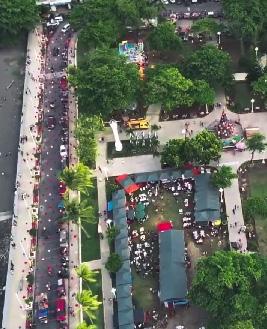
YOGI YO
One Call Away to Korean Indulgence
by Conie Bugas
“Yogiyo! Yogiyo!”
From the perspective of someone unfamiliar with the phrase, ‘Yogiyo’ might sound a bit fancy.
Meaning “over here” in Korean, “Yogiyo” has quickly become the go-to phrase for people entering and leaving the Korean restaurant.
Located near the athletic complex around MONHS, vibrant lights welcome guests into a sustainable interior, where friendly staff offers a warm welcome.
According to Ruzzell Abelo, one of the frequent diners of the place, the Korean restaurant is indeed a must-visit with tons of food to eat.
He also notes that even if you’re not a huge Korean food fan, ordering is easy thanks to the helpful waiters and cashiers who are happy to offer recommendations.
For Keziah Madula, the owner of the restaurant, an MONHS alumnus and whose mother is a former teacher of the school, the new business that she built serves a greater purpose, which deals being a hangout spot for students as well as a ministry, wherein they share the gospel through their inclusive bible quiz activities and verse displays as decorations on their walls.
The menu boasts a tempting array of dishes, including cheesy ramyeon, bulmen,
chapaghetti, spicy Korean chicken bowls, tteokboki, corn dogs, fish cakes, gimbap, and sotok sotok, a truly indulgent experience of authentic Korean cuisine.
Yogiyo Korean Restaurant in Oroquieta offers a delicious and unique dining experience. Its inviting atmosphere, friendly staff, and tempting menu of Korean favorites make it a must-visit, while its community-focused ministry adds a special touch.
With so much to offer, the taste of Korea is now within reach in Oroquieta, just a phone call away!

The Heartbeat of Oroquieta
Students’ Haven at the City Plaza
In the heart of Oroquieta, the city plaza serves as a sanctuary for students seeking a break from academic stress. It’s more than just a public space—it’s a lively meeting point where friendships flourish, moments are shared, and the energy of youth thrives.
With its mix of natural beauty and urban convenience, the plaza offers students a place to unwind after a busy day. As part of Oroquieta, a city known for its welcoming atmosphere and high quality of life, the plaza reflects the vibrant spirit of a place where people live well

A Serene Stroll Along the
The Food Court
The coastal boulevard provides a peaceful escape, where the gentle lapping of waves meets the expansive horizon. Students often gather here, watching the sun set or taking leisurely strolls along the pedestrianfriendly path, enjoying the cool breeze and serene views. It is also a route among fitness enthusiasts for morning or evening hike or jog.
After a day of lectures, the plaza’s food court is the perfect place for students to unwind and recharge. Offering variety of affordable and delicious street food—from isaw, kwekkwek, shawarma wraps, to a uniquely served chicken proven with gravy—it’s a popular hangout for satisfying cravings and connecting with friends. Laughter and lively conversations fill the air as students share stories, meals, and moments of camaraderie.
Plenty of Space to Sit, Relax, and Reflect
The plaza’s expansive layout offers plenty of places to sit, whether on well-
maintained benches or in the grassy areas. Students can relax, study, or simply enjoy the open space, making it a place for both socializing and solitude. Whether you’re catching up with friends, enjoying a quiet moment of reflection, or spending quality time with loved ones, the plaza provides the perfect ambiance. Oroquieta’s city plaza is a vibrant community where students come together to celebrate the end of another school day. It’s a place to share experiences, find peace after class, and nurture the friendships that define student life. As the sun sets and the plaza fills with warmth and energy, it reflects the spirit of Oroquieta itself—a city of good life, where people live in harmony with their surroundings and where the future brims with possibility.
by Rohannie Lawig
by Abegail Baco
FOOD FOR SEOUL. Yogi Yo launches the first-ever container van restaurant in Oroquieta City, offering a fresh ambiance and unique dining experience.
Photo by SUGBO MACCIATO
Photo by PAULA TAGUBAR
Photo by ALI NA! LAAG TA
HE or SHE - Shell Threat
Imposex and TBT contamination in Aninikad Species
The world’s oceans are vast with complex ecosystems teeming with all kinds of life. However, this delicate balance is increasingly threatened by human activity, such as pollution. Of particular concern is Imposex which disrupts the reproductive systems of sea snails such as “Aninikad” or Canarium urceus and other crustaceans.
Imposex is characterized by the development of male characteristics in female snails and is primarily caused by exposure to tributyltin (TBT), a potent endocrine disrupting chemical (EDC) once widely used in antifouling paints. Although TBT has been banned worldwide since 2008, its residues remain in coastal waters, especially in areas with heavy marine traffic or where older primers are still used.
In a study from University of the Philippines-Cebu by Kayzel Maata, a MONHS alumnus, fishing ports in the vicinity of Oroquieta City— the source of food and livelihood to people—were found to have numerous cases of imposex in species of “Aninikad,” which are known for popular local delicacies.
With this discovery, as female shells develop male characteristics, their ability to reproduce is compromised. Knowing that these species are severely affected, slowly the series of dominos to its population disrupts the natural order of the marine environment.
Revelation of TBT usage and silent extent in sexual trend.
According to Maata, shocking cases of sexual determination
among the Aninikad in Oroquieta show pounded evidence on tributyltin in coastal premises. Her study revealed a disturbing trend on imposex: coverage was found in 35% of Aninikad samples collected near the fishing port of Oroquieta, while further away it dropped to 4.76% and 4.55%. This association suggests a strong link between Imposex and TBT contamination.

Furthermore, the use of TBT in furnishing paints more likely to be found in fishing boats immensely creates routes to be regulated. More recreational paints that can be alternatives awaits the stop of imposex cases on Aninikad, which not only contradicts with pollutants that harms the marine life but promotes sustainable conservation and livelihood to Aninikad harvesters.
Effects on reproduction and population dynamics: the silent killer of marine life
Residing the effects on its population, imposex blocks the reproduction of affected females and diverts energy from egg production to the development of male characteristics that can lead to poor health, reduced reproductive success and species decline.

With the silent results of its imposex evolution, these marine gastropods are known to be the most sensitive to TBT exposure in terms of imposex and reproduction failure, whereas it is shell malformation for bivalves.
This highlights the devastating outcomes of TBT pollution on the reproductive health of marine gastropods, threatening the longterm survival of these species.
exposure to TBT from seafood consumption has been linked to a number of health hazards including endocrine disruption, this just relentlessly persist that the polluting TBT could be climbing silently its way to human bodies.
The need for waves on breaking silence: protecting our marine environment
The found marine problem in the Aninikad group is just a speck from the impact of human activities on the marine environment. It highlights the need for further research to understand the full extent of TBT contamination and its impact on marine life.
In addition, it emphasizes the importance of implementing sustainable practices, such as using environmentally friendly primer and reducing marine traffic in sensitive areas, to protect our oceans and ensure the health of marine ecosystems for future generations.
Combating for marine environmental change requires a collective effort. By raising awareness of the issue, supporting research and promoting responsible environmental practices, we can help protect these Aninikad and other species in the marine environment and preserve the delicate balance of the city’s marine life.

“Ang Malindang nagtawag. Kanimo, andam motubag.” Mount Malindang has always been in the hearts of the locals, even being immortalized in the provincial anthem of Misamis Occidental.
Nevertheless, did it all go downhill after the mountain that is said to have protected the people of Misamis Occidental failed to safeguard the people of its region?
We have always been hit with a downpour of rain in recent years—instead of absorbing the rainwater during the rainy season, it immediately drains it to the river channel that causes flood.
In an article about Mt. Malindang, it talked about the remaining rainforest in Mindanao Island in the Philippines, which is the home of the most diverse species of endemic, rare, and endangered wildlife, such as the pride of the Philippines and considered one of the rarest and critically endangered, the Philippine Eagle—also known as the country’s national bird—and the park is rich in terms of flora and fauna and, a feasible area for educational and research purposes.
This versatile peak demonstrates the need for greater government support, not only in terms of funding but also in sustainable resource management.
Investing in the preservation of Mt. Malindang would benefit not
only local communities but also the Philippine economy as a whole.
Our guardian of Mis. Occ. has contributed much to maintaining the health and welfare of the constituents in Misamis Occidental by providing clean water for domestic and agricultural uses, absorbing carbon dioxide of about 200,000 tons per year, and releasing oxygen of about 146,000 tons to the atmosphere.
Talairon Construction Dust

As construction of a new hospital progresses in Talairon, Oroquieta City, the air is filled with clouds of dust and gravel particles. The surrounding highways are coated with tons of dust, exposing residents to harmful inhalants that pose serious health risks.
According to World Health Solutions, excessive inhalation of dust particles leads to serious respiratory issues and even lung cancer.
“My day to day commute from home to school requires me to have constant vulnerability in inhaling these particles which results in my persistent coughing,” Hannah Jane Mascariñas, a resident in Talairon, honestly said.
While the human body has defense mechanisms to eliminate dust such as macrophages and white blood cells, these defenses weaken over time if the dust particles are too abundant or too large.

in Northern Mindanao. Subano is derived from the vernacular word “suba” which means river as they dwell near or along riverbanks.
A study by Work Safe found that a concentration of just 10 milligrams per cubic meter over an 8-hour period of dust can contribute to skin irritation and lung inflammation.
Moreover, construction sites, particularly those involving aluminum and iron, can exacerbate the issue, contributing to the accumulation of harmful particles in the air. When these particles settle in the lungs, they damage the respiratory system’s lining and can heighten allergic reactions.
“These irritant dust that ended up in my nasal passages inflamed the mucus membranes in my nose, triggering my rhinitis,” Elisha Pansinsoy, another resident from Talairon, stated. Hence, with construction expected to last for months, and possibly years, the ongoing exposure to this environmental pollution raises serious concerns about the long-term health impact on residents, particularly the most vulnerable populations.

poses health risks 14 SCIENCE-TECHNOLOGY
The creation of the Mt. Malindang Range Natural was also made as a natural park with regulations made by the government. It also has rich biological and physical resources of major ecological and economic value and now serves as the site for a biodiversity research initiative—the PhilippinesNetherlathe Biodiversity Research Programme (BRP) for Development in Mindanao: Focus on Mt. Malindang and its Environs.
Mount Malindang is not just for protection; it possesses unique assets not typically observed in other mountains, such as its biodiversity, and inhabitants like the only ethnic tribes existing in the province is the Subanon tribe who are the freedom loving people
For instance, Mt. Malindang’s flooding in the lowland area was mainly caused by poor practices and unchecked development in the upland areas, improper farming methods, and massive tree cutting, all of which are detrimental not only to biological resources but also to the human population that largely depends on them for survival.
I believe that we should get more support from mountain management agencies, as investing in resources to protect and sustain the mountain ecosystem can lessen the problems faced by the people of the Philippines. While this might be a rocky start, it would ultimately lead to a smooth, positive resolution.

Government and private sector backing could immensely help with the extension and implementation of livelihood projects as additional sources of income for upland communities, offering a solution to their ongoing dependence on limited resources.
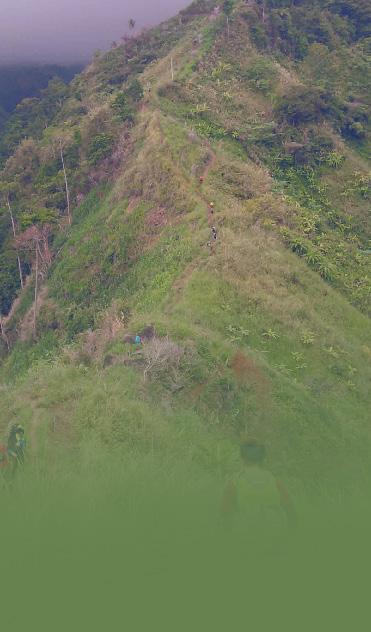
Mt. Malindang protection is considered ‘faulty,’ prompting government institutions to increase support.


by Tedj Fegi
by Rohannie Lawig and Conie Bugas
by Tedj Fegi
Photo by MT. MALINDANG RANGE NATURAL PARK
ATCHARAnghaeyo
The Benefits of the Kimchi-like Filipino Side Dish
by Tedj Fegi
If the iconic and beloved kimchi represents the signature dish of Koreans, the Philippines, too, has its own treasured counterpart in the form of the classic atchara, a traditional Filipino dish made from fermented green papaya.
Atchara is often served as a side dish to complement fried or grilled foods, particularly meat like the ever-popular pork barbecue, liempo or chicken inasal. It plays a similar role in Filipino cuisine as kimchi does in Korean cuisine, offering an indispensable flavor and health benefit.
The sweet and sour combination of atchara settles delightfully on the taste buds, enhancing the flavor of every meal it accompanies. This appetizer, with a texture and flavor profile akin to kimchi, is a beloved Filipino staple.
It is often paired with meat dishes, not only for its taste but also because of its digestive benefits. The papayas and jicama used in making atchara are rich in fiber, which help to pull toxins from the body, assist with digestion, and promote weight loss.
Furthermore, the vinegar that is integral to the dish doesn’t just provide that signature tangy flavor; it has the added benefit of helping to lower blood sugar levels, contributing to a sense of fullness and satisfaction after eating. The vinegar’s impact on blood sugar levels also makes it a valuable part of a balanced diet.
Additionally, the fermentation process that atchara undergoes boosts its nutritional content. During fermentation, beneficial digestive enzymes are released, creating an environment that fosters probiotic organisms, which promote gut health and overall digestion.
According to Kapampangan Media, the origins of atchara trace back to the Indian dish “achaar,” a pickled vegetable preparation originally developed as a method for preserving food during the lean seasons.
Atchara can be compared to kimchi in the sense that both are

pickled side dishes, though the flavor profiles differ in significant ways. One noticeable difference when comparing atchara to kimchi is the distinct smell of the dish. Atchara has a recognizable sour-andspicy tang, which is a key characteristic.
Another key ingredient in atchara is grated papaya, which sets it apart from kimchi, which typically uses cabbage as its base. Like kimchi, atchara also includes onions, peppers, and garlic. Once the atchara has been fermented, it takes on an amber color, which further adds to its unique aroma.
While both dishes are flavorful and tangy, it’s important to note that kimchi is generally spicier than atchara. The heat in kimchi comes from its use of chili peppers, whereas atchara tends to be milder in terms of spiciness but packs a punch in terms of its vinegar and garlic-based flavor.
Despite its unique flavor, impressive health benefits, and centuries of tradition, atchara remains relatively underappreciated outside the Philippines. The dish’s distinct taste and its healthpromoting properties deserve recognition on the global stage.
While atchara has long been a staple in Filipino households, it has largely remained unknown outside the Philippines, consumed mainly by locals without much external recognition or promotion.
To rectify this, it’s crucial that atchara receives more media attention and support. Whether through social media campaigns, culinary festivals, or cooking shows, featuring atchara can allow the world to experience and savor this flavorful, nutrient-packed dish. In doing so, the broader global community can come to understand and appreciate the importance of this dish in Filipino cuisine and culture.


Hurry, Pater: The One-Pastil-Meal Solution
An Approach to Nutrition in a Time-Crunched Society
By Rohannie Lawig
“Kungmagdali, pater ang kan-a (If in a hurry pastil is what you should eat).
Modern life is fast-paced, and the classic three-meals-a-day remains very much in vogue. Yet for many, the reality is a busy schedule that leaves little time for meal preparation or even eating.
In today’s time, most students would often go for the famous “Pastil” or also known as “Pater”, a dish from Mindanao that is made of wrapping steamed rice in banana leaves and adding shredded beef, chicken, or fish, as their go-to meal.
Depending on the type of toppings, this wrapped-up meal can already have a good amount of calories, proteins, fat, and carbohydrates.
According to Snap Calorie, when consuming the rice with beef shreds, a serving of one leaf-wrap can already contain a total fat of 23.66 grams, total carbohydrates of 70.98 grams, dietary fiber of 2.37 grams, total sugars of 4.73 grams, and a protein of 35.49 grams which is already equivalent to a protein packed smoothie.
For the case of chicken, a total of 200 calories is what you can get alongside 7 grams of carbohydrates, 4 grams of fat, and 25 grams of protein.
And as for fish pastil, it contains a total of 271 calories with 30 grams of carbohydrates, 8.3 grams of protein, 14 grams of total fat, 5.4 grams of dietary fiber, 346 milligrams of sodium, 0.3 micrograms of vitamin D, 52 milligrams of calcium, 1.8 milligrams of iron, and 590.6 milligrams of potassium.
With these nutritional values, such as proteins, vitamins and minerals, the pastil is indeed considered to be a balanced food.
According to Andra Farm, pastil is also a better alternative for fast food since it is not greasy due to it not being fried making it healthy for the heart.
As for Joriz Boniao, a student who is a regular pastil-eater, he likes the idea of pastil being the new fast food but healthier.
Alongside the use of banana leaves, this as well contributes to sustainability making it a cultural icon and an environmentalfriendly piece of meal.


In a study by the National Science and Technology Commission of Sri Lanka, banana leaves also give a good amount of antimicrobial properties and has a temperature tolerance property which helps extend shelf-life and can withstand temperatures of up to 100 degrees Celsius.
For the case of being time efficient, each wrap of food can already bring ease into its making since it requires less preparation such as not using super sealed plastics in ensuring its packaging. Also, the way it is layered from steamed rice in its bottom then shredded toppings can already be good enough for consumption.
In conclusion, the One-Pastil-Meal Solution is an innovative approach to
HOW HAVE YOU BEAN?
4 Harmful Effects that Coffee Poses
By Conie Bugas
Snutrition that caters to the demands of modern life. As people juggle their busy schedules, Pastil emerges as a practical and nutritious meal option that addresses the challenges of time constraints and dietary needs. Its time-efficiency allows for quick meal preparation, while its nutritional completeness ensures that essential nutrients are consumed even in a single meal. As our society continues to look for convenient yet healthy meal solutions, Pastil stands out, combining tradition with modern nutritional needs and offering a satisfying, nutritious option. Adopting this dish into daily life would lead to improved well-being, high energy levels, and better health, which can be especially valuable for those constantly moving in this fast-paced world, juggling multiple responsibilities.

lowly, in the cradle of today’s generation, coffee has become a staple to us in our day-to-day errands—making the drink one of the ‘holy grails’ that some cannot live a day without drinking. With rising coffee shops in Oroquieta City, people tend to hop in and out of their favorite cafes and even begin to know by heart the types of these fine breweries, in which we often neglect the hidden effects of what this cup of delight brings.
According to Dr. Jared Maecham, a nutritionist, although caffeine is generally safe in low-to-moderate amounts, high levels of consumption can cause unpleasant and even dangerous effects. This points out the question, “How far have we BEAN in feeling and knowing these side effects?”
Sip of Anxiety
Coffee is known to boost alertness which is perfect for the office setting. It works by triggering the release of adrenaline, the “fight-or-flight” hormone associated with increased energy. However, with an increased intake, coffee can lead to anxiety disorders.
According to Noemi Abelo, a regular coffee drinker, a few cups of it can elevate her jitteriness causing her heart to palpitate, which led her to stop drinking.

In a study by the Diagnostic and Statistical Manual of Mental Disorders (DSM), Caffeine-induced Anxiety Disorder is one of four caffeine-related syndromes where extremely high daily intakes of 1,000 milligrams or more per day have been reported to cause nervousness that can result in severe palpitations.
InsoMniac
Sleep has become a sacrifice for those who want to stay up late, which would not be possible without coffee. Although the intake of the drink has gone rapid, and sleep has become a premium experience.
Studies have found that higher
caffeine intake appears to increase the amount of time it takes to fall asleep.
For students, such as Cairon Simprota, a grade 12 student, sleep has been out of reach for her since coffee tends to be her partner in terms of late night studying, which affected her routine and body rest.
Moreover, insomnia is one of the leading effects of drinking caffeinated beverages. PubMed Central indicates while caffeine remains in your system for an average of five hours, the time period may range from one and a half hours to nine hours, depending on the individual. To sum it, caffeine can help you stay awake during the day, but it may negatively impact your sleep quality and quantity.
Saying Hi to High Blood Pressure
Increased chance of high blood pressure is also one of the effects of drinking too much coffee.
In the case of, Maura Pagalaran, a senior who describes herself as a “kape-barako lover”, due to old age, the strong coffee which was once a part of her identity, the drink more likely raises her blood pressure risking her for heart attack and stroke.
According to Michael D. Kennedy from the National Center for Biotechnology Medicine, it has been shown that coffee elevates blood pressure which addresses to heart attack and stroke, since it may damage arteries over time, restricting the flow of blood to the heart and brain. Although this can be another serious case, it’s likely fortunate since the effects of caffeine on blood pressure seem to be temporary.
Digestive Issue
For some people, coffee is one secret tool to help their bowels, given that coffee’s laxative effect has been attributed to the release of gastrin, a hormone the stomach produces that speeds up activity in the colon. With this, it is not surprising that countless people would use it to aid with their digestive problems. However, large doses of caffeine may lead to loose stools or even diarrhea in some people. PubMed Central indicates that caffeinated beverages may also worsen gastroesophageal reflux disease (GERD). This technically reveals that coffee should be taken moderately to avoid this effect.
Hence, coffee can be a go-to delight for all, but like everything else, too much of it can be bad. Trying to stop drinking this cup would often feel impossible, especially if it’s part of your routine. However, it’s better enough to be aware of the unhealthy side effects this pure cup of delight has on controlling the dosage and preventing the negative effects.
SCI-TECH

COAL-conut
OroCoco’s Innovative “Super Uling”
by Erlo Manimtim
In the capital of Misamis Occidental, a revolutionary product is turning waste into wealth.
Despite the hard time convincing people to change their typical charcoal chards, OroqCoco Super Uling, a charcoal briquette made from coconut shells, is not only ecofriendly but also highly efficient.
“Our charcoal is made from 100% coconut shell, the only other ingredient is corn starch which acts as a binder, “ said Yogesh Pellster, one of the brains behind OroqCoco Super Uling. Coconut shells produce the highest quality briquettes due to their density and carbon content which makes them burn longer and hotter than traditional charcoal.
Coconut shells are carbonized and mixed with a binder before being compressed into briquettes. “We tried different materials like sawdust and rice hull, but they didn’t produce the same quality as coconut shells,” explains Pellsäter. The dense structure of the coconut shell limits airflow and packs more energy per piece, resulting in longer burn times.
Coconut shells are carbonized, a process that converts the shells into a material rich in carbon. This carbonization process is crucial as it enhances the energy content of the material, making it an excellent source for fuel.
“Coconut shell charcoal is one of the cleanest and most popular sources of activated charcoal,” explained Loneza G. Carbonel, a researcher from Kalinga, Apayao State College. The dense structure of the coconut shell limits airflow and packs more energy per piece, resulting in longer burn times, making not only an efficient fuel but also beneficial for health due to its detoxifying properties.
The carbon content in coconut
shells. “Our coco shell charcoal leaves much less ash because it has fewer impurities,” Pellsäter stated. This results in a cleaner burning process, which is less harmful to both users and the environment.
Comparing to traditional charcoal, Pellsäter highlighted, “It burns equally hot and lasts for twice as long. Despite being slightly more expensive, the efficiency and longer burn time make it a costeffective option.” Businesses, in particular, recognize the savings and environmental benefits.
Tabon-tabon Triumph
‘Kinilaw Ingredient as Ointment’ places in RSTF
by Erlo Manimtim
Canan ingredient of kinilaw bring a breakthrough in medicine?
In response to the need for sustainable and effective healthcare solutions, Conie Marie M. Bugas developed the Tabon-tabon ointment, earning top honors at the Regional Science and Technology Fair 2024.

Focusing on businesses that need consistent heat for extended periods has been key to their marketing strategy. “Korean barbecue restaurants and small food businesses have been our main customers,” Pellsäter said. These businesses appreciate the efficiency and clean-burning properties of the briquettes.
The benefits extend beyond commercial use. Pellsäter emphasized, “Anyone can benefit from using our charcoal, whether for daily cooking or special occasions like fiestas.” The briquettes maintain high temperatures for longer periods, reducing the need for frequent refueling.
OroqCoco Super Uling has also provided livelihoods for many in Oroquieta. “The main purpose of Oroqcoco is to help farmers create better livelihoods by making highquality coconut products,” Pellsäter shared. By buying coconut shells from local farmers and providing jobs in production, the company supports

Tabon-tabon (Atuna racemosa) is known for its natural phytoconstituents like saponins, terpenoids, flavonoids, and alkaloids. These compounds aid in tissue regeneration and have anti-inflammatory properties.
“The effectiveness of my product revolutionizes the
potential of Tabon-tabon, which can be utilized in the field of medicinal practice, despite it being known primarily for its culinary contributions in our kinilaw delicacies in the Philippines,” Bugas explains.
With a pH level of 5, the ointment is gentle on the skin’s microbiome while efficiently promoting healing. The main scientific marvel lies in the bioactive compounds found in Tabon-tabon.
“Our studies show that the antioxidants in Tabontabon neutralize free radicals, preventing cell damage,” says Dr. Juanita Flores, a dermatologist. This combination

of ancient wisdom and modern science offers a powerful remedy for various skin ailments.
Research by the Philippine Institute of Traditional and Alternative Health Care highlighted the antimicrobial and antifungal properties of these compounds, making the ointment effective against common infections like Staphylococcus bacteria. Beyond its medicinal properties, Tabon-tabon ointment supports sustainable practices. Using locally sourced materials benefits the community and reduces reliance on synthetic chemicals.
Fishing Vessel (FIVESS)
PROtotype
MONHS researcher invents a sustainable solar-powered fishing vessel prototype
by Tedj Fegi
Traditional fishing methods are hard to operate and the reliance on diesel or petrol engines is too costly for fishermen.
As a result, a Grade 12 Science and Technology, Engineering and Mathematics (STEM) student from MONHS made a solar-powered boat as a prototype and alternative for fishermen to provide them a low-maintenance and costeffective solution.
Rizabelle Ianne L. Dybongco aims to assist fishermen by reducing their operational expenses, increasing their income, and ultimately improving their livelihood by offering a more sustainable and efficient fishing.
“Its potential to promote sustainability by introducing a renewable energy-powered fishing vessel. This can reduce our reliance on traditional fuelpowered boats, lower costs for fishermen, and minimize environmental pollution,” she innovatively stated.

The density of coconut shells means they produce less smoke and ash, which is a major environmental benefit
- Yogesh Pellster

Powered by renewable energy, the solar boat is ecofriendly and sustainable, featuring a quiet, pollutant-free electric motor that supports environmentally friendly fishing, with all materials used in the solar boat prototype rigorously tested for reliability, minimal wiring, and securely installed components ensuring safety and functionality.
“It operates quite well and reaches the standard levels of operation for its size,

and in comparing this to a lifesize boat of the same design, the results showed that it meets performance expectations,” proudly proclaimed Rizabelle. In terms of the sustainability provided by the prototype, FIVESS opens an opportunity to renewable source of transport for the dominant fishermen source in the vast regions of the archipelago.
According to the U.S. Embassy in the Philippines (.gov), solar-powered boats are very transformative technologies that address not only climate change mitigation but also support the livelihood and economy of communities.
“This research has allowed me to see how science and innovation can really aid in solving life problems. It’s not only about new inventions but about creating things that can make a difference, like helping to protect and preserve the environment and in supporting locals. Working on this project has taught me that even small ideas, like my solar-powered boat, can lead to bigger changes and motivate more solutions in the future,” she reflected.

ABC Boat Hire, a United Kingdom-based solar-powered boat creator, stated that the innovations in solar technology and battery efficiency continue to improve, making small solarpowered boats an increasingly viable option for both recreational and commercial use. Moreover, as renewable energy technology continues
to advance, the efficiency and affordability of solar-powered boats will likely improve, making them even more accessible to a wider range of fishermen, thus accelerating the transition to sustainable practices in the fishing industry.
Overall, the solar-powered boat provides significant environmental and economic benefits by reducing carbon emissions, cutting fuel and maintenance costs for fishermen, promoting sustainable fishing practices, improving livelihoods, and contributing to long-term conservation efforts. However, it does have minimal limitations related to development, testing, and the need for ongoing research and adaptation in different environments.


Photo by RIZABELLE DYBONGCO
- Rizabelle Dybongco
Photo by PEOPLE OF OROQUIETA
Paula Tagubar

“The potential of Tabon-tabon can provide additional livelihood for growers and offers a cost-efficient, organic option for consumers,” says Bugas. The product stands out in the market by avoiding harmful chemicals found in commercial ointments.
Moreover, the Tabon-tabon ointment aligns with the global push for eco-friendly and organic products. By utilizing the natural resources of the region, it minimizes the carbon footprint associated with commercial ointments.
“The development of affordable and accessible wound care solutions is one of the highlights of my study, offering a broader perspective for many people who do not have access to synthetic drugs due to expense,” Bugas highlighted.
Conie Bugas’s Tabon-tabon ointment is not just a product. It is a beacon of hope for future healthcare. By blending traditional practices with modern science, it promises a brighter, more sustainable future for communities.
As Dr. Flores eloquently puts it, “The best of nature is sometimes hidden in plain sight, waiting to be rediscovered and revered.”
The benefits of Tabon-tabon extend far beyond health, fostering not only economic growth but also environmental conservation. As communities increasingly embrace this natural remedy, the ancient and the modern meet in perfect symbiosis, blending

tradition with innovation and promising a brighter, more sustainable future.

SandGen
First Prototype of Sand Harnessing Energy secures spot in Science Fair
Despite being the first prototype, due to perseverance, success after countless trials was as fine as sand.
From hardships to triumphs, “SandGen”, one of the first of its kind, a sand battery that utilizes solar energy made a highlighting impact in the Regional Science and Technology Fair (RSTF) along with its researcher, Sheizanrah Obani, a grade 10 learner from MONHS by bagging fourth place in the said event.
According to her, the innovation sparked a unique impression, capturing the panelists’ attention by promoting another way of embracing renewable source of energy. With that, she expressed that the contribution of the device is beneficial to communities with a need for it.
Here in the Philippines, with an abundance of sand in coastal areas particularly due to being an archipelago, one of the innovative ideas Obani got was harnessing energy to power up even barangays where sand is near.
“I further noticed that there was also a lack of small-scaled renewable energy sources available to communities, especially here in the Philippines because of economic challenges. This motivated me to develop a device that utilized and harnessed an already abundant material (sand) here in the Philippines,” she said.
Featuring an energygenerating model, SandGen has the ability to turning heat from absorbing the sand with its own generative properties.
According to the American Society of Civil Engineers, studies are now digging the potential of the ability of sand to be used to create energy on demand and store it in the long term.
Showcasing a similar strategy like how other renewable
resources such as hydropower, geothermal, and solar plants— the prototype paves a modern path for sustainable power production.
However, being in a research situation that dealt with it being new, Obani added that the process of doing the study made her run through different challenges which gave her a rough time and at a moment caused her to lose hope.
“Since the SandGen is the first prototype, the trial-anderror period of the device had to be the most difficult part of the whole study, especially at a time the weather was not quite favorable for the testing. It gave me a lot of discouragement and the time-crunch was stressful,” she stated.
In order to bounce from a low point, her perseverance and strong support lifted her up and made her regain strength to continue her study.
“Thanks to the support and help of my advisers, coresearchers, and groupmates, it made the battle more tolerable. Their support gave me the motivation, courage, and perseverance to continue and finish the study,” Obani expressed.
With a purpose to carry, her solid deal to helping coastal communities and even a nationwide scale, Obani’s “first of its kind” study opened a door to profound potential by bringing future energy generating innovations to heat from sand as its source. Because of persisting through,
despite numerous setbacks, her journey of strength and effort made its way to the top.

Sand as material will then have a prospective approach in powering future communities with this -Sheizanrah Obani
MorinGALING
Pushed by the dilemma of underutilized Moringa seeds in the community of Oroquieta, the innovation of a product out of these continuously paved a way for an alternative vegetable oil source, marking a MorinGALING discovery.
This is what grade 10 student researchers, Chloe Sumagang, Hannah Abella, and Wayne Quiñon recently drew a line in the newer ways the Malunggay (Moringa Oleifera) plant can offer. Capturing the essence of the seed and turning it into a vegetable oil, according to them, the study started off as observing that Malunggay seeds are often overlooked with only the leaves being recognized for its benefits.
industries, including cosmetics, pharmaceuticals, and food. Meanwhile, according to Quiñon, their product is also well-documented for its effectiveness in various applications, including skincare, hair care, and as a food ingredient, particularly in salad dressings or lowheat applications.
Furthermore, the study also reaps a purpose for communities by engaging a cost-effective source of oil, contributing to local industries while promoting the efficient use of natural resources, helping livelihood and offering brighter alternatives.

“Most of the attention was given only to the plant’s leaves. We wanted to explore the potential other parts of the plants like the seeds, which in our study, we aimed to create a vegetable oil, opening opportunities for innovation, sustainability, and even economic benefits for the community,” said Sumagang
Highlighting the advantage of their vegetable oil which was made in a hot-pressed method, the researchers noted that the product uses a higher extraction method that yields in higher amounts which lowers production costs.
Moreover, compared to regular oil, the Moringa seed vegetable oil has a lower boiling point which is fit enough for salad dressing alternative.

“The smoke point of our oil is at 116°C, which does not meet the criteria for high-temperature cooking. Based on our results, the malunggay seed vegetable oil has a mean starting temperature of 31°C, a smoke point of 116.07°C, and an average time of 3.31 minutes before visible smoke appears,” Abella stated.
In addition, the nutritional values contributed by the Malunggay seed also creates the fact that in terms of it being healthy, the vegetable oil is naturally made with Malunggay’s known “good for use” qualities.
In a study by MedIndia, moringa seeds are widely recognized for their nutritional and therapeutic properties, and the oil extracted from them has been used in various
With the innovation of such product, Abella, Quiñon, and Sumagang also bagged second place in the Regional Science and Technology Fair holding the result of their hard work and perseverance into their vegetable oil study.
So, from overlooking the Malunggay seeds to fulfilling a solution and even earning a place for their innovation, Abella, Quiñon, and Sumagang’s teamwork pulled out enormous efforts and contribution which marks indeed as a morinGA-LING discovery.

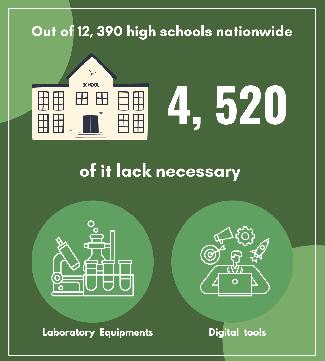

Photo by FRANCHEZCA PARAGUYA
by Conie Bugas
by Tedj Fegi
Photo by JESSIE GABRIEL BESIOHAN
Photo by CONIE BUGAS

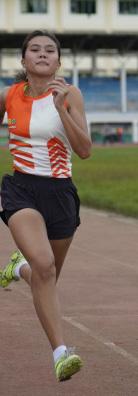
INJURE-RUNS
Cagas returns after injury; qualifies for Nmraa meet
by FIELLE CLARENCE FUENTIVILLA
2024.

After she recovered from her injury last year, Cagas secured the spot to Northern Mindanao Regional Athletic Association (NMRAA), while Misamis Occidental’s representative came in second place, followed by the runner from Tangub at third.
“I’m very happy to the point that I don’t know how to explain it, because I did not expect that I could acquire the gold medal as I wasn’t able to compete last year due to my injury,” Cagas said after topping the game.
Meanwhile, Cagas finished 2nd in the 100-meter dash with a time of 13.61s to secure a silver medal, while she grabbed bronze in both of her 4×100 and 4×400 relay events. Furthermore, Cagas shared the immense pressure she felt during the game after she transferred into being a sprinter from Walkathon last year where she now found her potential being a runner. “I now found where I really belong,” Cagas said.

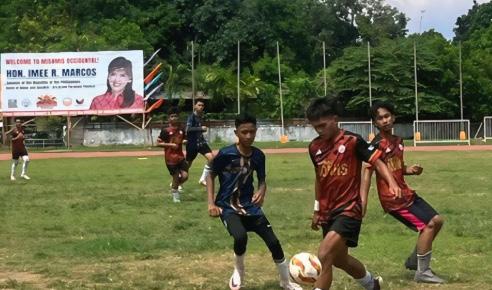

HISTORIC GOAL
Monhs goals landslide win against HRS, 2-0
by CHRISTIAN ANGELO PASTRANO
MONHS dominated the games with their consistent defense, not letting HRS build their momentum that resulted to HRS’ fall , making MONHS score a 3-0 lead in both of their games in the tournament, 6-0.
“It felt so amazing, imagine napilde namo ang one of the strongest kalaban namo, maong dako kaayong kalipay namo gyud adtong nidaog mi sa Division Meet, because sa 2 years namo nga dinula, nakuha ra gyud namo ang championship,” Lance Jorienz Potutan, MONHS’ team captain and center back player, expressed
gratitude after the triumph.
Potutan added that, the absence of HRS’ main players gave them the advantage to overpower their opponent— outplaying HRS through teamwork and built strategies.
“Katong nidaog mi, 6-0 against HRS, grabe among kalipay, especially knowing nga they’re usually one of our strongest rivals in Football. But, we knew that their
It’s really a huge achievement for us because after 2-3 years, the championship in Football comes back to MONHS - LANCE JORIENZ POTUTAN
missing players gave us [the] advantage. We trained tirelessly, stayed focused, and worked together as a team,” Potutan further explained how they managed to beat HRS.
Moreover, MONHS’ Spiker, Kiandemz Usero, got injured during the first game, taking a significant loss to the team’s contrbution.
However, MONHS remained their posture and stayed focus, trying to bag the win despite the
substitution of one of their main players.
“Kadtong na-injured na gyud akong kauban or sent off during the game, it was tough, but we didn’t lose hope. At first, we felt worried and a bit discouraged, but we quickly reminded ourselves to stay focused and keep fighting. Our mindset was to give our best no matter what and to support each other as a team,” Potutan said.
Meanwhile, MONHS’ triumph marked a significant step to their journey, as they will face stronger teams in the Provincial Meet on December 11-14, 2024.
Conversely, Cagas also expects her next journey to be challenging as she returns to NMRAA.
“It’s always been my dream to win gold in the NMRAA. That is why, I will fight all the obstacles just to achieve my dream,” Cagas stated.
Prior to her upcoming game, Cagas begins her training with uphill runs every morning to enhance her stamina, as well as additional runs every afternoon to establish endurance.
Esick’s court strategy exhausts Villanueva, clinches gold


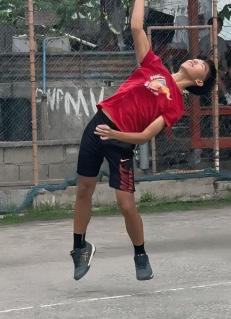
A quick and dominating game for Oroquieta City’s Sean Andrei Esick as he outpowered Charles Villanueva from Misamis Occidental in the final round of the Men’s Individual Lawn Tennis, 7-0, held at Oroquieta Lawn Tennis Association (OLTA), December 13.
Esick completely disregarded Villanueva’s aggressive strategy, outsmarting his opponent by draining his energy that led to a complete sweep.
Esick expressed his frustration after he joined the tournament with only two days of training after being injured in the first day of gearing-up prior to his game.
“Wala nako nagamit amo training time kay na injured [ko] sa first day of training namo, maong two days before the game nako naka practice,” Esick stated
Moreover, it was a quick match for Esick, where he completely dominated the game, claiming all seven sets, bagging the gold for Oroquieta.

“Wala lang ko ga expect na ma zero nako akong kalaban kay siya pod ako kontra last sa Tangub, pero lakag among dula with 8-6 score, which is gamay rag ligas,” Esick added
Meanwhile, Esick is now in preparation for the Northern Mindanao Regional Athletic Association (NMRAA), hoping to claim gold in his second try after not being able to bag gold last NMRAA.

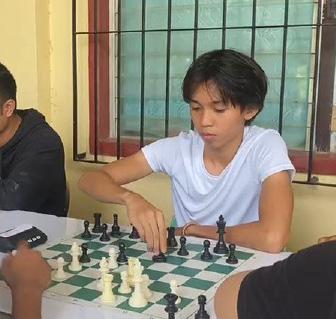
by Christian Angelo Pastrano
RjayBrylle Iyog from MONHS placed 1st at the Division Meet Chess Tournament with an undefeated victory, dominating both five rounds in Standard and Blitz Chess on October 16, 2024.
Despite the immense pressure against his opponent in the third round of Blitz category Placido Parohinog Jr., Iyog remained composed
Chess Tournament
and secured the win by taking advantage of Parohinog’s pawn structure and piece activity, performing a consistent attack to Parohinog’s defense that resulted to Iyog’s triumph.
“My journey isn’t really that easy, especially in my third round of Blitz Chess, but all I did was really playing safe and wait until he do a bad move,” Iyog explained.
Iyog confessed that, he got the early advantage in his last game, ending his journey with a quick win against Lance Palanas,5-3, where in the middle of the game, Iyog’s officials ere already positioned, giving him confidence with his pawn sructure.
Meanhile, Iyog said that it’s a tough journey for him, after going against strong players across the city.
Nonetheless, Iyog expressed his excitement to compete with stronger players in the upcoming Provincial Meet, hoping to advance in the Northern Mindanao Regional Athletic Association (NMRAA).
“Although I’m nervous, I’m just also excited to play against stronger players at the Provincial Meet and I hope I can qualify for NMRAA.
MONHS runner Angel Christine Cagas, dominated the field after clinching gold medal in the girls’ 200-meter sprint event with a 28.89s time during the Provincial Meet
Misamis Occidental National High School’s (MONHS) swept Holy Rosary School (HRS) with an impressive 2-0 win, breaking HRS’ winning streak in the 2024 Asenso Division Meet Football Tournament, held at the Misamis Occidental Provincial Athletic Complex (MOPAC) Grandstand.
by CHRISTON DELA CRUZ
Charles Villanueva
Sean Andrei Esick
Photo by JESSIE BESIOHAN
ONGOING COMEBACK. Sean Andrei Esick puts more smashes in court, aiming high to shine through NMRAA.
Photo by Gecarl Siega
LANDSLIDE GOAL. MONHS throws strong kicks, sweeping HRS after consecutive goals.
Photo by PAULA TAGUBAR
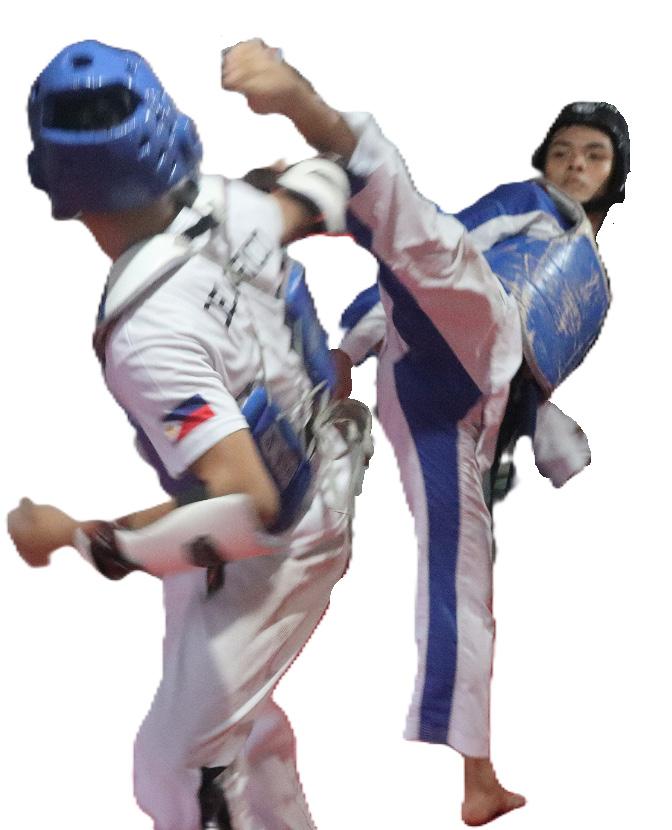
19 SPORTS
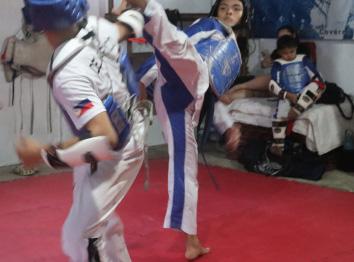
GOLDEN
KICK COMEBACK!
Acar stuns Alviar, bags gold in Taekwondo
by FIELLE CLARENCE FUENTIVILLA
BjAcar showed no mercy against Francis Dale Alviar, after crushing him in Taekwondo where he won both two consecutive rounds, bagging the gold medal during the One Asenso Provincial Meet on December 13, securing a spot for the Northern Mindanao Regional Athletic Association (NMRAA).
This victory marked Acar’s return to the top, proceeding to another level where he improved his performance to
perform better this year after only settling for the bronze medal, facing the taste of defeat in last year’s NMRAA.
“I was happy and thankful to God that I was able to win in the Provincial Meet and to be able to play again in NMRAA, I have taken another chance to win again and surpass my last year’s level,” expressing his emotions he felt after winning the game.
Meanwhile, in the final match, Acar controlled the match with confidence, using his experience to outclass Alviar, using
his skill advantage that resulted to a wide gap in the score between them, earning him a decisive victory.
“I wasn’t nervous at all, because I saw that I had the advantage in the game and our score was too far, especially that I also have someone supporting me,” he said.
Moreover, Acar started the match with a roundhouse kick followed by a 45 follow-up out, effectively knocking out his opponent.
In the second round, Acar maintained his techniques and didn’t
let his momentum break using 45 follow-ups in and out, repeating his technique along with the normal kicks.
Meanwhile, Acar pointed out that he solely focused on the head of the enemy and body shots, minimizing unnecessary movements to maintain its control; thus maintaining its lead throughout both rounds. In the meantime, Acar is now eagerly gearing up in Villaflor, as he will be proudly presenting Oroquieta City in the upcoming NMRAA to be held in March.
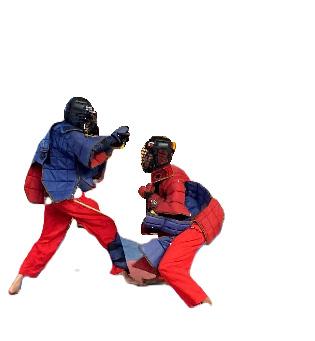
Monhs Arnis secures ticket to Provincial Meet
by CHRISTIAN ANGELO PASTRANO
After long preparation
advanced to the Provincial Meet after the withdrawal of their supposedly first-ever opponent from Mobod Integrated School (MIS)
According to Jlove Quibol, Señor Arnisador and twotime Northern Mindanao
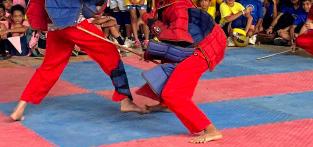
SSLG assures Sports Fest comeback
by CHRISTIAN ANGELO PASTRANO
The Supreme Secondary Learner Government (SSLG) of MONHS assured the conduction of the most anticipated Sports Fest this year, tentatively on February, after not being able to administer it last year. Due to last year’s Sports Fest proposal being rejected, this year’s SSLG meticulously
Regional Athletic Association (NMRAA) qualifier, MIS backed out due to lack of preparation and poor condition of their athletes at the Division Meet 2024.
“Sayang kay naa na unta mi opponent but at the same time okay ra kay naa pamay next year wherein mas maka prepare sila,” Quibol expressed her reaction after the withdrawal of MIS.
Despite the withdrawal of MIS, MONHS team continued their intensive trainings, engaging in a week intensive exhibitions given by the school to prepare athletes and waste no time focusing on their individual improvements as
prepared the necessary necessities and requirements needed to successfully continue the annually celebrated event.
“Late na kaayo mi nagpropose last year, that’s why they rejected our proposal and advised us to really submit a proposal two weeks early from the event,” SSLG President Aldryn Kwek stated with a smile.
they go back in facing their teammates.
While the set competition is cancelled, Arnis coach Johana Marie Obregon explained how the Arnisadors prepare intensely and are ready to strike with full force as they perform in the upcoming Meet.
“We ensure the team to maintain their trainings and continue as they still be competing despite the withdrawal of their opponents,” Obregon said.
In the upcoming Provincial Meet, MONHS is set to perform an exhibition game, in preparation to their match between their teammates in the following days.
New Sports in MONHS
MONHS opened four new sports:


Langam’s Knockout Dream
by ABEGAIL SHANE BACO
Jonathan Langam, a Grade 12 STEM student at MONHS, has faced more struggles than most teenagers. At just 17, he was on the verge of something big in boxing, but a family conflict forced him to put his dreams on hold. Despite his talent and hard work, Jonathan missed the chance to compete in the provincial meet, which could have led to the Palarong Pambansa, due to his father’s condition: continue boxing and lose financial support for college.
Jonathan’s journey began in Calamba, where street sparring was common. He became interested in boxing in ninth grade, drawn by his love for new experiences. “I’ve always loved to try new things,” he said. Though the bruises and injuries were frequent, he never regretted it, seeing it as a way to release stress. During 11th grade, a small
misunderstanding with his father led Jonathan to run away, seeking refuge at his aunt and uncle’s home in Oroquieta City. There, he found support for his boxing, something his father never approved of. When he transferred to MONHS, Jonathan learned about boxing tryouts and quickly signed up. Out of more than 50 hopefuls, he was chosen as one of 11 athletes for the City Meet, and the team was automatically qualified for the Provincial Meet, a key step toward competing in the Palarong Pambansa.
Confident he could make it, Jonathan trained hard. “I really believed I could go far,” he said. But when his


by FIELLE CLARENCE FUENTEVILLA

Sports vs Acads: Combat is not only at court
Athletes are often seen as reliable and hardworking, complimented by their dedication and determination. Yet, when it comes to academics, they don’t get applauded as much. It’s not because they lack the ability but because of their irresponsibility. Frequently, they are involved more in the sports community than in educational responsibilities, even relying on excuses and the system that compensates for their academic challenges. If athletes show how much they commit to their sports, why can’t they apply the same idea to academics?
In my opinion, their dedication to sports is commendable, but it shouldn’t come to the point that it harms their education. Many of them use the school’s system, using their demanding schedules as a defense to excuse academic efforts. This reliance not only hinders their full potential but also shows that they can only pursue sports, having only one task that they can do.
The truth about balancing academics and sports is not an impossible task, it only requires the same time management that athletes apply to their training. To some extent, it is a fact that it is not easy but in their training to be an athlete, they have the will to push forward even when being pressured, which could also mean that they can work hard and persist under pressure. If they could attend more to their studies, they could perform excellently in both. It would be easier if athletes took responsibility now, not just on the court but also in their classrooms.
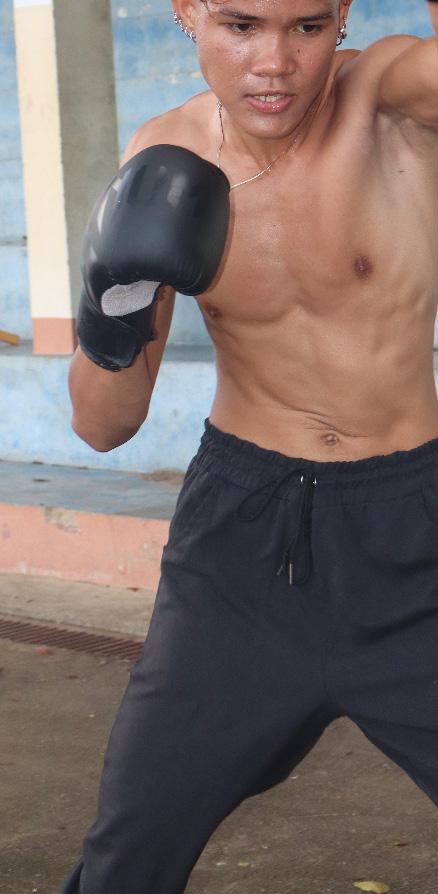

father found out about his boxing involvement, he threatened to withdraw his financial support for college if Jonathan continued. Torn between his passion and his future, Jonathan made the difficult decision to pull out of the Provincial Meet. His story is one of resilience, tough decisions, and sacrifice. It’s a reminder that sometimes, the hardest battles happen outside the
Moreover, in an interview with a teacher majoring in sports, he talked of an incident where their student was skilled enough to play during the Provincial Meet but did not qualify because all his grades failed. He was too focused on playing basketball that he forgot to attend to his education. This clearly shows the lack of balance between academics and sports can have serious consequences.
Athletes get more obsessed with medals, to the point where they care less about other important things in their lives such as examinations and classroom activities, which results in blocked opportunities.
In conclusion, the irresponsibility of athletes not only hinders their full potential but also all their opportunities to play their field. It becomes problematic if they are not responsible both as a student and as an athlete.
This also concerns teachers, knowing that their students are failing in grades. To address this situation, athletes mostly get excused in class, and not all excuses are exempted from activities given, but they could get a private tutor and homework to catch up on the missed lessons. This not only helps the athletes to have passing grades but also helps them to have opportunities as wide as possible.
MONHS Arnis Team
FORBIDDEN DREAM. Jonathan Langam throws heavy punches, training hard for Boxing despite the disapproval of his father.
Photo by PAULA TAGUBAR





Shackles of Disparities
I
’ve always had this thought in my head: Why is someone immediately labeled as “gay” or “lesbian” when they play a sport dominated by the opposite gender? Everyone supposed to have the right to enjoy sports, but with gender still being a huge basis, I’ve come to terms with the fact that even after countless attempts to advocate for equality, we are still a generation who’s trapped in past stereotypes and sexism. No, it’s not just some shallow debate of superiority, but rather a societal issue of inclusion and acceptance that’s still severely ignored.
The lack of female representation in MONHS, especially in sports is disappointing. What’s more is the constant discrimination women and the LGBTQIA+ community face from not only from students but also teachers. Instead of educating for good, this school is the one failing us by still serving inequality and not urging for proper change. In fact, men aren’t the only ones capable as gender is not a foundation for someone’s abilities.
Gymnast and an LGBTQIA+ member Carlo Ceballos revealed that people doubted him because he’s gay. Furthermore, the overload rules for men to cut their hair short was also a factor for his hesitation to join. Despite being a power house, Monhs is still a place of prejudice. Equality in treatment and equity in competitions is what the school should follow but the disparity is what causes us to lag behind because promising students aren’t supported enough due to gender biases.
Moreover, The Nation said that this stems from misinterpretations of biological differences which is unfortunately prevalent in this school. I believe anything a man can do, women can do too as it’s not a matter of strengths but ability and passion competing. It’s time to start accepting and not just tolerating because in the end, everyone deserves to be comfortable and happy.



We all have the ability to excel but this school isn’t doing us justice. Sports is a space for passion and inclusion but it is tainted with inequality which is why there is a need to change this. Monhs needs to go beyond just tolerance and embrace true equality. Ability, dedication and love for sports should be the basis and not stereotypes.
Let’s start by promoting equal opportunities for everyone. Ensuring quality education and programs to avoid gender-based discrimination can evoke a new type of acceptance and inclusivity among students. Lastly, female and LGBTQ athletes should be set as examples in order to encourage and promote promising athletes.

COMEBACK DENIED
OroTreasures bow to Tangub,
Fighting Maroons dominated the 1st set with their continuos attacks, but Tangub strengthened their defense, outpowering Oroquieta with a 6-point lead.
However, Fighting Maroons managed to take the lead after consecutive aces and blocks, with Kemph Yuri Lumayaga carrying his team with his consistent attacks and defense, tying the match in a 1-1 score.
The game became intense in the last set of the match, with both teams’ scores close to each other, climbing their way to the win and
grab the chance of going against the defending champions, Misamis Occidental.
Unfortunately, the two main players from the Fighting Maroons experienced cramps during the crucial part of the game with a close score of 22-22, giving Tangub the chance to outpower Oroquieta, ending the match with a 25-23 score.
“That was really so unfortunate for us. We were really aiming high and hoping to get the championship but fell short in our semi finals game,” expressed John Lloyd Canoy after the loss.

The Fighting Maroons won against Tangub in the preliminary rounds with a clean sweep, 25-17, 25-20. However, the luck took turns in the semifinals.
“Hapit na gyud unta, we were on our way kay amo man silang napilde sa first nga laban namo and dako kaayo ug biya, but na outpower lang gyud mi nila sa semi tungod sa injured players namo,” Lumayaga said.
With this loss, the Fighting Maroons failed to get their revenge against Misamis Occidental, after they lost against them in the finals last Provincial Meet, which had left them hungry for redemption.
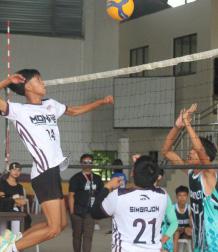
Orotreasure’s pitching skills led victory, strikes Tangub, 6-3
by CHRISTON DELA CRUZ
MISAMIS OCCIDENTAL — A spectacular game to the Oroquieta Baseball team as they bagged a 6-3 victory over Tangub on December 12, 2024 in a spectacular display of skill and determination.
John Steve Siete’s consistent pitching excellence was the tool in securing the win, resulting in a total of five strikeouts. His impressive performance put pressure on Tangub’s lineup and ultimately led to Oroquieta’s victory.
Moreover, Kyle Del Pilar’s early homerun provided a crucial boost, giving Oroquieta an early lead that would prove difficult for Tangub to overcome.
Von Axel Quiap also made significant contributions, striking out two players from the opposing team and helping Oroquieta gain an advantage.
Before their big win against Tangub, Oro Baseball Team had already shown their mettle in a series of tune-up games
leading up to the Palaro. In these matches, the team has shown strength and cohesion, securing consecutive wins, including the recent 6-3 victory over Tangub.
Lifted by this success, the team is now focusing on maintaining their winning streak as they prepare for upcoming matches.
Oroquieta’s victory is a testament to the team’s hard work and determination, and they will look to continue their success in future matches.
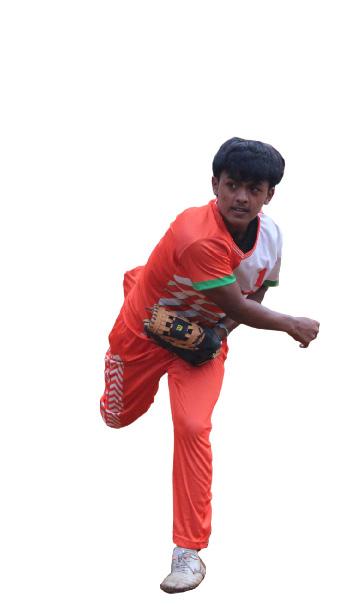
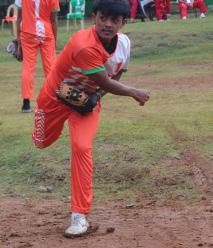
First time attempt: get back with gold in their eyes
s MONHS was filled with great athletes, they have made a great feat as they shine like a diamond yet hidden under the pocket waiting to be seen. Even if this was their first time competing, gymanstics from MONHS has taken medals proving that they can keep their heads high even when their event is newly established.
Enough with the days and time, yet the team remained faithful with their training program. They faced many challenges and repeated activities that proved their
resiliency and consistency in competing at the highest level despite having limited time for preparation.
“Although gymnastics is new, I think I’ve found my talent here; we’ve also bagged medals from the Provincial Meet, which is already a significant achievement for us,” Carlos Ceballos, a gymnast and former volleyball player, shared.
Yet, he mentioned the lack of proper training as a significant drawback for gymnastics, especially since it is still a relatively new sport at MONHS.
Moreover, he stated that
the main factor affecting their performance is the lack of an experienced coach, as they are unfamiliar with the necessary techniques, which further delays their progress and prevents them from fully reaching their full potential.
“Our coach is still not familiar with the terminologies or the training routines. We still have a long way to go,” he said.
Additionally, this sport has recently gained popularity among students, especially following the success of Carlos Edrian Yulo, an Olympic gold medalist. His remarkable achievement made
them realize that gymnastics is not only fun but also mentally and physically challenging, despite the stigma that it’s a sport primarily for women.
“I think Carlos Yulo represents us,” he added.
Although they failed to qualify for the Northern Mindanao Regional Athletic Association (NMRAA), the athletes remain hopeful of competing again next year. They aim to promote gymnastics among students, inspire greater participation, foster school spirit, and ultimately expand their community for future success.
isamis Occidental — Oroquieta City’s Figting Maroons Men’s Volleyball team fell short against Tangub City in a thrilling 3-set match, 19-25, 25-22, 23-25, failing to secure their slot in the finals, ending their journey with bronze.
FIELLE CLARENCE FUENTIVILLA
by MARNEL KEISHA CABURAL
by CHRISTIAN ANGELO PASTRANO
1-2
pitching,
Photo by PAULA TAGUBAR
